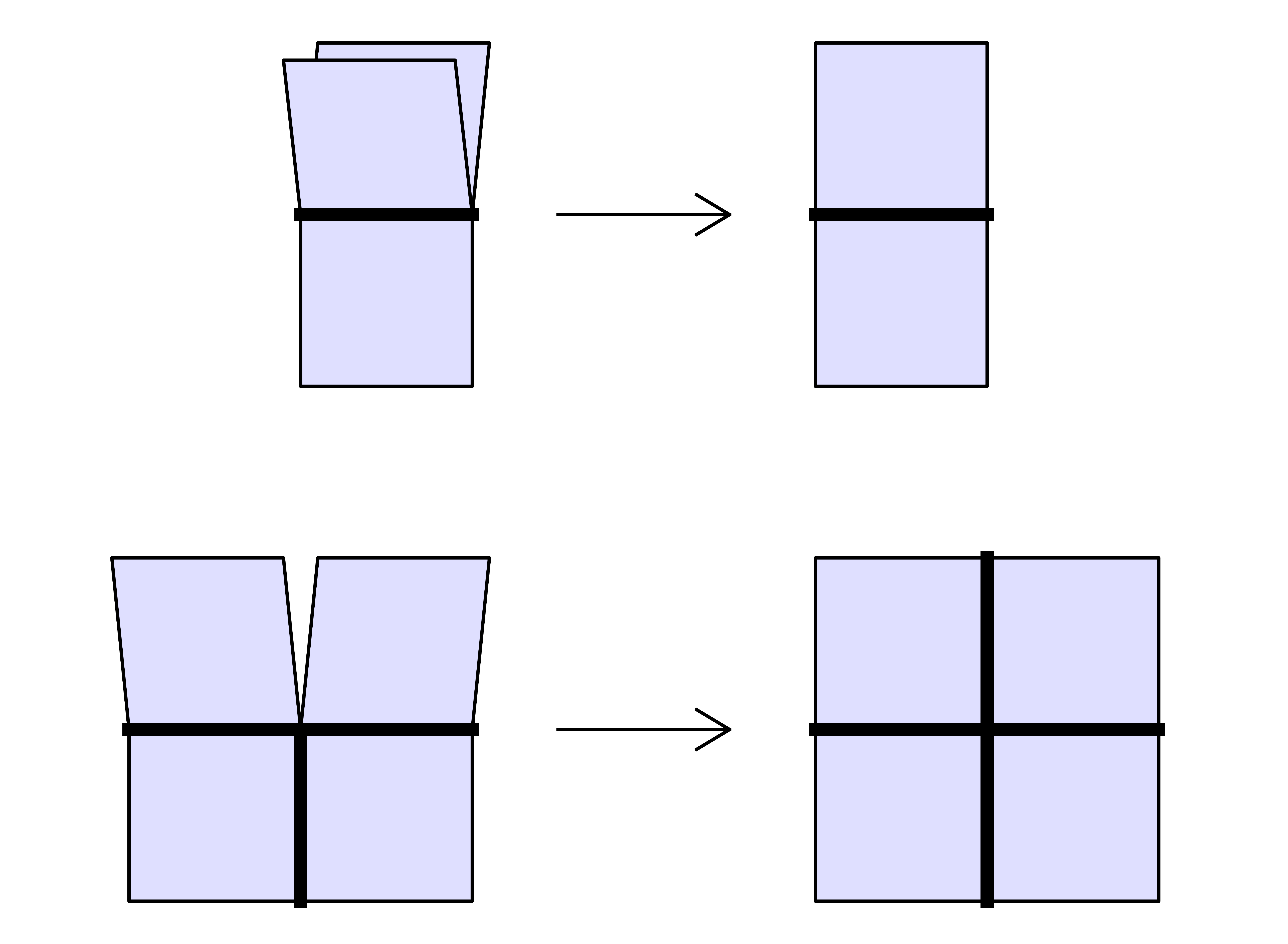 is given by an
approximation algorithm which takes
is given by an
approximation algorithm which takes  with
with  on input and which produces an
on input and which produces an  -approximation
-approximation  for
for  with
with  . One defines computable complex numbers in a
similar way.
. One defines computable complex numbers in a
similar way.
|
Until now, the area of symbolic computation has mainly focused on the manipulation of algebraic expressions. It would be interesting to apply a similar spirit of “exact computations” to the field of mathematical analysis. One important step for such a project is the ability to compute with computable complex numbers and computable analytic functions. Such computations include effective analytic continuation, the exploration of Riemann surfaces and the study of singularities. This paper aims at providing some first contributions in this direction, both from a theoretical point of view (such as precise definitions of computable Riemann surfaces and computable analytic functions) and a practical one (how to compute bounds and analytic continuations in a reasonably efficient way).
We started to implement some of the algorithms in the
|
Although the field of symbolic computation has given rise to several softwares for mathematically correct computations with algebraic expressions, similar tools for analytic computations are still somewhat inexistent.
Of course, a large amount of software for numerical analysis does exist, but the user generally has to make several error estimates by hand in order to guarantee the applicability of the method being used. There are also several systems for interval arithmetic, but the vast majority of them works only for fixed precisions. Finally, several systems have been developed for certified arbitrary precision computations with polynomial systems. However, such systems cannot cope with transcendental functions or differential equations.
The first central concept of a systematic theory for certified
computational analysis is the notion of a computable real
number. Such a number  is given by an
approximation algorithm which takes
is given by an
approximation algorithm which takes  with
with  on input and which produces an
on input and which produces an  -approximation
-approximation  for
for  with
with  . One defines computable complex numbers in a
similar way.
. One defines computable complex numbers in a
similar way.
The theory of computable real numbers and functions goes back to Turing [Tur36] and has been developed further from a theoretical point of view [Grz55, Alb80, BB85, Wei00]. It should be noticed that computable real and complex numbers are a bit tricky to manipulate: although they easily be added, multiplied, etc., there exists no test for deciding whether a computable real number is identically zero. Nevertheless, possibly incomplete zero-tests do exist for interesting subclasses of the real numbers [Ric97, MP00, vdH01b]. In section 2.5, we will also introduce the concept of semi-computable real numbers, which may be useful if a zero-test is really needed.
The subject of computable real numbers also raises several practical and
complexity issues. At the ground level, one usually implements a library
for the evaluation of basic operations  ,
,
 ,
,  , etc. and special functions
, etc. and special functions  ,
,  ,
,
 , etc. Using fast
multiplication methods like the FFT [KO63, CT65,
SS71], this raises the question of how to do this in an
asymptotically efficient way [Bre76a, Bre76b,
CC90, Kar91, vdH99a, vdH01a,
vdH05b]. At an intermediate level, one needs a software
interface for certified operations with arbitrary precision numbers.
Several implementations exist [FHL+05, GPR03,
Mül00, vdH99b, vdH06b],
which are mostly based on correct rounding or interval arithmetic [Moo66, AH83, Neu90, JKDW01,
BBH01, Bla02]. At the top level, one may
finally provide a data type for real numbers [MM96, Mül00, Lam06, O'C05, vdH06a,
vdH06b]. Given the real number result of a complex
computation, an interesting question is to globally optimize the cost of
determining a given number of digits of the result, by automatically
adjusting the precisions for intermediate computations [vdH06a,
vdH06b].
, etc. Using fast
multiplication methods like the FFT [KO63, CT65,
SS71], this raises the question of how to do this in an
asymptotically efficient way [Bre76a, Bre76b,
CC90, Kar91, vdH99a, vdH01a,
vdH05b]. At an intermediate level, one needs a software
interface for certified operations with arbitrary precision numbers.
Several implementations exist [FHL+05, GPR03,
Mül00, vdH99b, vdH06b],
which are mostly based on correct rounding or interval arithmetic [Moo66, AH83, Neu90, JKDW01,
BBH01, Bla02]. At the top level, one may
finally provide a data type for real numbers [MM96, Mül00, Lam06, O'C05, vdH06a,
vdH06b]. Given the real number result of a complex
computation, an interesting question is to globally optimize the cost of
determining a given number of digits of the result, by automatically
adjusting the precisions for intermediate computations [vdH06a,
vdH06b].
The next major challenge for computational analysis is the efficient resolution of more complicated problems, like differential or functional equations. In our opinion, it is important to consider this problem in the complex domain. There are several reasons for this:
Most explicitly stated problems admit analytic (or semi-analytic) solutions.
The locations of the singularities of the solutions in the complex plane give important information on the optimal step-size for numerical algorithms.
The behaviour of the solutions near singularities gives important information on the nature of these solutions.
Analytic functions are very rigid in the sense that they are entirely determined by their power series expansion at a point, using the process of analytic continuation.
This paper aims at providing a basic theoretical framework for computations with computable analytic functions and effective analytic continuation. When possible, our study is oriented to efficiency and concrete implementability.
The history of analytic continuation of solutions to complex dynamical systems goes back to the 19-th century [BB56]. Although interval arithmetic and Taylor models have widely been used for certified numeric integration of dynamical systems [Moo66, Loh88, MB96, Loh01, MB04], most implementations currently use a fixed precision [Ber98]. Some early work on effective analytic continuation in the multiple precision context was done in [CC90, vdH99a, vdH01a, vdH05b]; see also [vdH07] for some applications. Of course, fast arithmetic on formal power series [BK75, BK78, vdH02b] is an important ingredient from the practical point of view. Again, the manipulation of computable analytic functions is very tricky. For instance, even for convergent local solutions to algebraic differential equations with rational coefficients and initial conditions, there exists no general algorithm for determining the radius of convergence [DL89]. Of course, one also inherits the zero-test problem from computable complex numbers.
Let us detail the structure and the main results of this paper. In section 2, we start by recalling some basic definitions and results from the theory of computable real numbers. In particular, we recall the concepts of left computable and right computable real numbers, which correspond to computable lower resp. upper bounds of real numbers.
In section 3, we introduce the concept of a computable
Riemann surface. In a similar way as computable real numbers are
approximated by “digital numbers” in  , we will approximate computable Riemann surfaces by
so called “digital Riemann surfaces”, which are easier to
manipulate from an effective point of view. For instance, in section 3.2, we will see how to identify two branches in a digital
Riemann surface. However, from a conceptual point of view, it is not
always convenient to see Riemann surfaces as limits of sequences of
digital approximations. In sections 3.4 and 3.5,
we will therefore discuss two equivalent ways to represent computable
Riemann surfaces. Notice that all Riemann surfaces in this paper are
above
, we will approximate computable Riemann surfaces by
so called “digital Riemann surfaces”, which are easier to
manipulate from an effective point of view. For instance, in section 3.2, we will see how to identify two branches in a digital
Riemann surface. However, from a conceptual point of view, it is not
always convenient to see Riemann surfaces as limits of sequences of
digital approximations. In sections 3.4 and 3.5,
we will therefore discuss two equivalent ways to represent computable
Riemann surfaces. Notice that all Riemann surfaces in this paper are
above  .
.
The next section 4 deals with constructions of several
kinds of computable Riemann surfaces. We start with the definition of
computable coverings (which can be thought of as morphisms of computable
Riemann surfaces) and the construction of the limit of a sequence of
coverings. We proceed with the definition of disjoint unions, covering
products, quotients and joins at a point. For instance, if  and
and  are the Riemann surfaces of
two analytic functions
are the Riemann surfaces of
two analytic functions  resp.
resp.  , then
, then  and
and
 are defined on the covering product
are defined on the covering product  of
of  and
and  . In section 4.4, we consider Riemann
surfaces which admit a distinguished point, the root. This allows for
the definition of a smallest “organic” Riemann surface which
contains a prescribed set of “broken line paths”. Universal
covering spaces and so called convolution products of rooted Riemann
surfaces are special cases of organic Riemann surfaces.
. In section 4.4, we consider Riemann
surfaces which admit a distinguished point, the root. This allows for
the definition of a smallest “organic” Riemann surface which
contains a prescribed set of “broken line paths”. Universal
covering spaces and so called convolution products of rooted Riemann
surfaces are special cases of organic Riemann surfaces.
In section 5, we come to the main subject of computable
analytic functions. In [vdH05a], a first definition was
proposed. Roughly speaking, the idea was to see a computable analytic
function as an instance  of an abstract data type
of an abstract data type
 , with methods for computing
, with methods for computing
The coefficients of  .
.
A lower bound  for the radius of convergence
of
for the radius of convergence
of  .
.
An upper bound  for
for  on any disk of radius
on any disk of radius  .
.
The analytic continuation  of
of  from
from  to
to  , with
, with  .
.
This point of view is very natural from a computational point of view if we want to solve a differential or more general functional equation, since it is often possible to locally solve such equations. However, the computed bounds are usually not sharp, so we need some additional global conditions in order to ensure that analytic continuation can be carried out effectively at all points where the solutions are defined.
Now the more systematic theory of computable Riemann surfaces of this
paper makes it possible to directly define the concept of a computable
analytic function on a given computable Riemann surface. Although this
makes definitions easier, one still has to show how to construct the
Riemann surface of a computable analytic function. Using the results
from section 4, we will do this for many classical
operations, like  ,
,  ,
,  ,
,
 ,
,  ,
,  ,
,  ,
,  ,
algebraic and differential equations, convolution products, etc.
Especially in the case of convolution products, the global knowledge of
an underlying Riemann surface is very important. What is more, we will
show that it is possible to construct the Riemann surfaces
incrementally, on explicit demand by the user. Also, whereas all
underlying Riemann surfaces from [vdH05a] were simply
connected, the present theory enables us to identify certain branches
where the function takes identical values. Nevertheless, the local
approach from [vdH05a] remains useful, because any
“locally computable analytic function” induces a natural
“globally computable analytic function” (see theorem 5.7).
,
algebraic and differential equations, convolution products, etc.
Especially in the case of convolution products, the global knowledge of
an underlying Riemann surface is very important. What is more, we will
show that it is possible to construct the Riemann surfaces
incrementally, on explicit demand by the user. Also, whereas all
underlying Riemann surfaces from [vdH05a] were simply
connected, the present theory enables us to identify certain branches
where the function takes identical values. Nevertheless, the local
approach from [vdH05a] remains useful, because any
“locally computable analytic function” induces a natural
“globally computable analytic function” (see theorem 5.7).
During the implementation of some of the algorithms from [vdH05a]
in our  and
and  could lead to
extremely inefficient algorithms. Therefore, it is essential to have
algorithms for the efficient computation of accurate bounds. In section
6, we will study this problem in a systematic way. Our
leitmotiv is to work with truncated power series expansions at
an order
could lead to
extremely inefficient algorithms. Therefore, it is essential to have
algorithms for the efficient computation of accurate bounds. In section
6, we will study this problem in a systematic way. Our
leitmotiv is to work with truncated power series expansions at
an order  with a bound for the remainder. On the
one hand, we will study how such expansions and bounds can be computed
efficiently and accurately (sections 6.3 and 6.4).
On the other hand, we will show how to use them for computing the
absolute value of the smallest zero of an analytic function (section 6.1) and for computing extremal values on a compact disk
(section 6.2). Several of the ideas behind our algorithms
already occur in the literature about Taylor models and polynomial root
finding. However, the context is a bit different, so our exposition may
have some interest for its own sake.
with a bound for the remainder. On the
one hand, we will study how such expansions and bounds can be computed
efficiently and accurately (sections 6.3 and 6.4).
On the other hand, we will show how to use them for computing the
absolute value of the smallest zero of an analytic function (section 6.1) and for computing extremal values on a compact disk
(section 6.2). Several of the ideas behind our algorithms
already occur in the literature about Taylor models and polynomial root
finding. However, the context is a bit different, so our exposition may
have some interest for its own sake.
For the sake of simplicity, we have limited ourselves to the study of
univariate analytic functions. It should be possible to generalize to
the multivariate case along the same lines. The main extra difficulty we
foresee is integration, because it requires an automatic algorithm for
the deformation of paths. Nevertheless, in sections 4.8 and
5.5, we study convolution products, and a similar approach
might be used for integration. Some of the algorithms in this paper have
been implemented in the
We assume that the reader is familiar with basic notions of the theory
of Turing machines. We recall that a Turing machine  computes a function
computes a function  , where
, where
 if the Turing machine does not halt on the input
if the Turing machine does not halt on the input
 . A function
. A function  is said to be computable if
is said to be computable if  for some
Turing machine
for some
Turing machine  . A subset
. A subset
 of
of  is said to be
recursively enumerable, or shortly enumerable, if
is said to be
recursively enumerable, or shortly enumerable, if  or if there exists a Turing machine
or if there exists a Turing machine  with
with  . We say that
. We say that  is computable if both
is computable if both  and
and
 are enumerable. Denoting by
are enumerable. Denoting by  the set of Turing machines, there exists a bijection
the set of Turing machines, there exists a bijection  , whose inverse encodes each Turing machine by
a unique natural number.
, whose inverse encodes each Turing machine by
a unique natural number.
More generally, an encoding (or effective
representation) of a set  is a partial
surjective function
is a partial
surjective function  , which is not
necessarily injective. In that case, we call
, which is not
necessarily injective. In that case, we call  (or
more precisely the pair
(or
more precisely the pair  ) an
effective set. If
) an
effective set. If  is computable or
enumerable, then we call
is computable or
enumerable, then we call  an abstract
computable resp. enumerable set. For
instance, the set of Turing machines which halt on all inputs is an
effective set, but not an abstract computable set, because of the
halting problem. If
an abstract
computable resp. enumerable set. For
instance, the set of Turing machines which halt on all inputs is an
effective set, but not an abstract computable set, because of the
halting problem. If  and
and  are effective sets, then so is
are effective sets, then so is  ,
for the encoding
,
for the encoding  , where
, where
 . By induction,
. By induction,  is an effective set for each
is an effective set for each  .
Many other classical sets, like finite sequences or trees over an
effective set admit straightforward encodings, which will not be
detailed in what follows.
.
Many other classical sets, like finite sequences or trees over an
effective set admit straightforward encodings, which will not be
detailed in what follows.
A function  between two effective sets
between two effective sets  and
and  is said to be
computable if there exists a Turing machine
is said to be
computable if there exists a Turing machine  such that
such that  for all
for all  .
In that case, each
.
In that case, each  with
with  provides an encoding for
provides an encoding for  ,
and we denote by
,
and we denote by  the effective set of
all computable functions from
the effective set of
all computable functions from  to
to  . A partial function
. A partial function  is
said to be computable if there exists a Turing machine
is
said to be computable if there exists a Turing machine  with
with  for all
for all  .
.
Sometimes, it is convenient to allow for generalized encodings  , where
, where  is
another encoded set. Indeed, in that case, the composition
is
another encoded set. Indeed, in that case, the composition  yields an encoding in the usual sense. For instance,
yields an encoding in the usual sense. For instance,  , where
, where  encodes each function
encodes each function  by the Turing machine
which computes it. Given
by the Turing machine
which computes it. Given  , we
will write
, we
will write  and
and  .
To each object
.
To each object  , given by its
encoding
, given by its
encoding  with
with  ,
we may naturally associate its representation
,
we may naturally associate its representation  in
in  . However, this
association does not lead to a mapping
. However, this
association does not lead to a mapping  ,
since we do not necessarily have
,
since we do not necessarily have  .
In particular, in order to implement a computable function
.
In particular, in order to implement a computable function  via a computable function
via a computable function  ,
using
,
using  , one has to make sure
that
, one has to make sure
that  whenever
whenever  .
.
An  -ary relation
-ary relation  on an effective set
on an effective set  is said to be
computable, if there exists a computable subset
is said to be
computable, if there exists a computable subset  of
of  , with
, with  . Equivalently, we may require the
existence of a computable function
. Equivalently, we may require the
existence of a computable function  with
with  for all
for all  .
Similarly,
.
Similarly,  is enumerable, if there
exists an enumerable subset
is enumerable, if there
exists an enumerable subset  of
of  , with
, with  .
This is equivalent to the existence of a computable function
.
This is equivalent to the existence of a computable function  with
with  for all
for all  . Here
. Here  denotes the set
of increasing computable functions
denotes the set
of increasing computable functions  ,
divided by the equivalence relation
,
divided by the equivalence relation  with
with  . Notice that
. Notice that  and
and  are equal as sets, but not as
effective sets. A computable function
are equal as sets, but not as
effective sets. A computable function  will be
called an ultimate test. Notice that the equality relation on
an effective set
will be
called an ultimate test. Notice that the equality relation on
an effective set  is not necessarily computable
or enumerable, even if
is not necessarily computable
or enumerable, even if  is an abstract computable
set.
is an abstract computable
set.
Since a subset  is also a unary relation on
is also a unary relation on  , the above definition in
particular yields the notions of computable and enumerable subsets of
, the above definition in
particular yields the notions of computable and enumerable subsets of
 . We also define
. We also define  to be a sequentially enumerable subset of
to be a sequentially enumerable subset of  if
if  or if there exists a
computable function
or if there exists a
computable function  with
with  . Similarly, we say that
. Similarly, we say that  is
sequentially computable if both
is
sequentially computable if both  and
and
 are sequentially enumerable. If
are sequentially enumerable. If  is sequentially enumerable and
is sequentially enumerable and  admits a
computable equality test, then
admits a
computable equality test, then  is enumerable. If
is enumerable. If
 is enumerable and
is enumerable and  is an
abstract enumerable set, then
is an
abstract enumerable set, then  is sequentially
enumerable. If
is sequentially
enumerable. If  is sequentially computable, then
is sequentially computable, then
 is an abstract enumerable set.
is an abstract enumerable set.
There are several other interesting notions which deserve further study,
but which will not be used in what follows. For instance, we may define
a subset  of an effective set
of an effective set  to be pseudo-computable, if there exists a computable function
to be pseudo-computable, if there exists a computable function
 with
with  ,
where
,
where  is defined similarly as
is defined similarly as  . For instance, given a Turing machine
. For instance, given a Turing machine  , the set
, the set  is a pseudo-computable subset of
is a pseudo-computable subset of  .
.
Let  be the set of digital or
dyadic numbers. Given an ordered ring
be the set of digital or
dyadic numbers. Given an ordered ring  , we denote
, we denote  ,
,  , etc. Given
, etc. Given  and
and
 , we say that
, we say that  is an
is an  -approximation
of
-approximation
of  if
if  .
An approximator for
.
An approximator for  is a computable
function
is a computable
function  which sends
which sends  to
an
to
an  -approximation of
-approximation of  . If
. If  admits
such an approximator, then we call
admits
such an approximator, then we call  a
computable real number and encode
a
computable real number and encode  by
by
 . We denote by
. We denote by  the set of approximators and by
the set of approximators and by  the effective set of computable real numbers.
Given
the effective set of computable real numbers.
Given  , both the problems of
testing whether
, both the problems of
testing whether  resp.
resp.  are undecidable.
are undecidable.
The usual topologies on  and
and  naturally induce topologies on
naturally induce topologies on  and
and  . Given an open subset
. Given an open subset  of
of  , an element of
, an element of  is called a computable real function. Notice that
such a function admits a natural encoding by an element
is called a computable real function. Notice that
such a function admits a natural encoding by an element  , where
, where  .
Many classical functions like
.
Many classical functions like  ,
,
 ,
,  ,
,  ,
,  ,
,  ,
,
 are easily seen to be computable. It can be
shown (see [Grz55, Grz57, Wei00]
and theorem 2.3 below) that a computable real function is
necessarily continuous. Consequently, the step and stair functions are
not computable. Intuitively speaking, this stems from the fact that the
sign function cannot be computed effectively for computable real
numbers.
are easily seen to be computable. It can be
shown (see [Grz55, Grz57, Wei00]
and theorem 2.3 below) that a computable real function is
necessarily continuous. Consequently, the step and stair functions are
not computable. Intuitively speaking, this stems from the fact that the
sign function cannot be computed effectively for computable real
numbers.
It is convenient to express part of the semantics of computations with
computable real numbers by providing a signature for the available
operations. For instance, the class  comes with
two main functions
comes with
two main functions

Similarly, the class  provides operations
provides operations

However, we take care not to provide functions for comparisons.
There exist many equivalent definitions for computable real
numbers and several alternative encodings [Wei00, Chapter
4]. A particularly interesting alternative encoding is to define an
approximator (or two-sided approximator) of  to be a computable function
to be a computable function  with
with

and  . This definition admits
two variants: a left approximator (resp. right
approximator) of
. This definition admits
two variants: a left approximator (resp. right
approximator) of  is a computable increasing
(resp. decreasing) function
is a computable increasing
(resp. decreasing) function  ,
with
,
with  . A real number is said
to be left computable (resp. right
computable) if it admits a left (resp. right)
approximator.
. A real number is said
to be left computable (resp. right
computable) if it admits a left (resp. right)
approximator.
Intuitively speaking, a left (resp. right) computable real
number corresponds to a computable lower (resp. upper)
bound. Indeed, in what follows, it will frequently occur that we can
compute sharper and sharper lower or upper bounds for certain real
numbers, without being able to compute an optimal bound. We denote by
 ,
,  ,
,  and
and  the left and right analogues of
the left and right analogues of  and
and  .
.
Remark  of extended
digital numbers. This leads to natural counterparts
of extended
digital numbers. This leads to natural counterparts  ,
,  ,
,
 , etc.
, etc.
Remark  of approximators
of approximators  correspond to the estimated
cost of the computation of
correspond to the estimated
cost of the computation of  (see also [vdH06b]).
We also notice that left, right and two-sided approximators can be
implemented by a common class real with a method approximate, which returns a bounding interval
(see also [vdH06b]).
We also notice that left, right and two-sided approximators can be
implemented by a common class real with a method approximate, which returns a bounding interval  as a function of
as a function of  .
In the case of left (resp. right) approximators, we would
have
.
In the case of left (resp. right) approximators, we would
have  (resp.
(resp.  ).
).
Let  be an open subset of
be an open subset of  or
or  . A function
. A function  is said to be lower continuous (resp. upper
continuous), if for every
is said to be lower continuous (resp. upper
continuous), if for every  and every
and every  (resp.
(resp.  ),
there exists a neighbourhood
),
there exists a neighbourhood  of
of  , such that
, such that  (resp.
(resp.  ) for all
) for all
 . We have [Grz55,
Grz57, Wei00]:
. We have [Grz55,
Grz57, Wei00]:
 be an open subset of
be an open subset of  . Then
. Then
Any  is continuous.
is continuous.
Any  is lower continuous.
is lower continuous.
Any  is upper continuous.
is upper continuous.
Proof. We will prove (b); the other two
assertions are proved in a similar way. The function  admits an encoding
admits an encoding  . Let
. Let  with approximator
with approximator

Let  be a left approximator for
be a left approximator for  . Given
. Given  ,
there exists a
,
there exists a  with
with  . Now the computation of
. Now the computation of  by
by
 only depends on
only depends on  for some
finite
for some
finite  . Increasing
. Increasing  if necessary, we may assume without loss of generality
that
if necessary, we may assume without loss of generality
that

Let  , with approximator
, with approximator  . For a certain
. For a certain  , we have
, we have  .
Now consider the alternative approximator
.
Now consider the alternative approximator  of
of
 with
with  for
for  and
and  otherwise. Then, by
construction,
otherwise. Then, by
construction,  satisfies
satisfies  . We conclude that
. We conclude that  .
.
The “lower step function”  ,
defined by
,
defined by  if
if  and
and  otherwise, is lower computable in the sense that
otherwise, is lower computable in the sense that
 . Indeed, given
. Indeed, given  , we may take
, we may take  .
Similarly, the function
.
Similarly, the function  is lower computable,
while
is lower computable,
while  is upper computable. In particular, this
shows that
is upper computable. In particular, this
shows that  . Besides the
projections
. Besides the
projections

typical lower computable functions on  are:
are:

Here the dot in  indicates the
argument of the function
indicates the
argument of the function  .
Left computable numbers are turned into right computable numbers and
vice versa by the following operations:
.
Left computable numbers are turned into right computable numbers and
vice versa by the following operations:

More generally, increasing computable real functions induce both increasing lower and upper computable real functions, while decreasing computable real functions turn left computable real numbers into right computable real numbers and vice versa.
The complexification  of
of  provides a natural definition for the set of computable complex
numbers. Typical operations on
provides a natural definition for the set of computable complex
numbers. Typical operations on  include
include

The complexification  of
of  also provides a natural encoding for
also provides a natural encoding for  and,
setting
and,
setting  , the approximation
function for numbers in
, the approximation
function for numbers in  extends to
extends to

Clearly, functions like  ,
,
 ,
,  , etc. can only be defined on simply
connected subsets of
, etc. can only be defined on simply
connected subsets of  . On the
other hand,
. On the
other hand,  is effectively algebraically
closed in the sense that there exists an algorithm which takes a
polynomial
is effectively algebraically
closed in the sense that there exists an algorithm which takes a
polynomial  of degree
of degree  on
input and which returns its set of
on
input and which returns its set of  roots in
roots in
 .
.
For many applications, the absence of computable comparisons
for computable real or complex numbers can be a big problem. One
solution to this problem is to systematically consider all possible
answers of zero tests or sign computations and to use these answers as
hypotheses during subsequent tests. For instance, if we assume that
 , then a subsequent test
, then a subsequent test  should return
should return  .
.
The above approach can be formalized as follows. A system of real
constraints is a pair  with
with  and
and  for
for  .
We say that
.
We say that  is satisfied if
is satisfied if  for
for  . We denote
by
. We denote
by  the set of systems of real constraints. A
semi-computable real number is encoded by a computable function
the set of systems of real constraints. A
semi-computable real number is encoded by a computable function
 , where
, where  is a finite subset of
is a finite subset of  such that at least one
element of
such that at least one
element of  is satisfied and
is satisfied and  whenever both
whenever both  and
and  are
satisfied. We denote by
are
satisfied. We denote by  the set of
semi-computable real numbers. A semi-computable function is a
function
the set of
semi-computable real numbers. A semi-computable function is a
function  . Such a function
naturally induces a function
. Such a function
naturally induces a function  .
Indeed, given
.
Indeed, given  , encoded by
, encoded by
 , we may take
, we may take  and
and  , whenever
, whenever
 .
.
Example  is semi-computable. Indeed, given
is semi-computable. Indeed, given  , we first compute an
, we first compute an  -approximation
-approximation  of
of  with
with  (e.g.
(e.g.  ) and
) and  .
If
.
If  , then we let
, then we let

and take  . Otherwise, we let
. Otherwise, we let

and take  with
with  and
and  .
.
From a practical point of view, computations with semi-computable
numbers can be implemented using non-deterministic evaluation and we
point to the similarity with the computation with parameterized
expressions [vdH97, Chapter 8]. Each branch of the
non-deterministic computation process comes with a system  of real constraints in
of real constraints in  .
A constraint checker is used in order to eliminate branches for which
.
A constraint checker is used in order to eliminate branches for which
 is contradictory.
is contradictory.
In many applications, the numbers  belong to a
polynomial algebra
belong to a
polynomial algebra  and one may use classical
algorithms from real algebraic geometry to check the consistency of
and one may use classical
algorithms from real algebraic geometry to check the consistency of  [BPR03]. Modulo further progress in
automatic proofs of identities [Ric92, Zei90,
vdH02a], we hope that more and more powerful constraint
checkers will be constructed for increasingly general classes of
constants (like algebraic exp-log expressions in
[BPR03]. Modulo further progress in
automatic proofs of identities [Ric92, Zei90,
vdH02a], we hope that more and more powerful constraint
checkers will be constructed for increasingly general classes of
constants (like algebraic exp-log expressions in  ). This would allow for the automatic elimination of
a large number of inconsistent branches. Notice also that it is
recommended to spend a roughly equivalent time in trying to prove and
disprove constraints. Of course, proving
). This would allow for the automatic elimination of
a large number of inconsistent branches. Notice also that it is
recommended to spend a roughly equivalent time in trying to prove and
disprove constraints. Of course, proving  is
easy, since it suffices to find a non zero digit of
is
easy, since it suffices to find a non zero digit of  .
.
As in the case of computations with parameterized expressions, many
algorithms for computable real numbers naturally generalize to
semi-computable real numbers. This is due to the fact that all numbers
involved often belong to a fixed polynomial algebra  , in which the Noetherianity of this algebra
may be used in termination proofs. We refer to [vdH97] for
examples.
, in which the Noetherianity of this algebra
may be used in termination proofs. We refer to [vdH97] for
examples.
Remark  , for a certain number
, for a certain number  of fixed subsets of the real numbers. However, we have not yet found any
practical use for such a generalization.
of fixed subsets of the real numbers. However, we have not yet found any
practical use for such a generalization.
A classical Riemann surface (above  ) is a topological space
) is a topological space  , together with a projection
, together with a projection  , so that every
, so that every  admits a
neighbourhood
admits a
neighbourhood  for which
for which  is a homeomorphism of
is a homeomorphism of  on an open ball of
on an open ball of  . A Riemann surface
. A Riemann surface  with border
with border  is defined similarly,
except that each
is defined similarly,
except that each  now admits a neighbourhood
now admits a neighbourhood  for which
for which  is a homeomorphism
of
is a homeomorphism
of  on a subset of
on a subset of  which
is homeomorphic to
which
is homeomorphic to  . A
classical covering is a local homeomorphism
. A
classical covering is a local homeomorphism  between two Riemann surfaces, which commutes with the projections,
i.e.
between two Riemann surfaces, which commutes with the projections,
i.e.  .
Throughout this paper, coverings are not required to be
surjective.
.
Throughout this paper, coverings are not required to be
surjective.
An encoding of a digital Riemann surface is a tuple  , where
, where  is a finite set of nodes,
is a finite set of nodes,  a scale,
a scale,  a projection and
a projection and  a symmetric adjacency relation, such that
a symmetric adjacency relation, such that
If  , then
, then  .
.
If  and
and  are such
that
are such
that  , then
, then  .
.
Let  be such that
be such that  for
for  and such that three relations among
and such that three relations among
 ,
,  ,
,  and
and  hold. Then the fourth relation holds as well.
hold. Then the fourth relation holds as well.
The conditions DR2 and DR3 are
illustrated in figure 3.1 below. In the case when  with pairwise distinct projections
with pairwise distinct projections  and
and  satisfy
satisfy  ,
then we will also write
,
then we will also write  . Notice that
. Notice that
 .
.
 |
Let us show how to associate a Riemann surface  in the classical sense to an encoding
in the classical sense to an encoding  as above.
To each
as above.
To each  , we may associate a
compact square
, we may associate a
compact square  by
by

We now consider the topological space

where  is a copy of
is a copy of  for
each
for
each  . Whenever
. Whenever  , the squares
, the squares  and
and  admit a common edge in
admit a common edge in  .
Gluing the corresponding copies
.
Gluing the corresponding copies  and
and  together in
together in  according to this edge
determines a new topological space
according to this edge
determines a new topological space

The space  is a Riemann surface with a border,
whose projection on
is a Riemann surface with a border,
whose projection on  is naturally determined by
the projections of the
is naturally determined by
the projections of the  on
on  . Indeed, DR2 (resp.
DR3) implies that points on the edges
(resp. vertices) of the
. Indeed, DR2 (resp.
DR3) implies that points on the edges
(resp. vertices) of the  are either
in the interior of
are either
in the interior of  or on its border. The
interior
or on its border. The
interior  of
of  ,
endowed with its natural projection on
,
endowed with its natural projection on  ,
is a Riemann surface in the classical sense; we call it the digital
Riemann surface associated to
,
is a Riemann surface in the classical sense; we call it the digital
Riemann surface associated to  .
It will be convenient to write
.
It will be convenient to write  and denote the
interior of
and denote the
interior of  by
by  .
More generally, if
.
More generally, if  , then we
write
, then we
write  and
and  for its
interior.
for its
interior.
Example  is injective, then the induced
projection
is injective, then the induced
projection  is a homeomorphism on its image. In
that case, we will identify
is a homeomorphism on its image. In
that case, we will identify  with the subset
with the subset  of
of  , and
call
, and
call  a digital subset of
a digital subset of  . Conversely, any
. Conversely, any  together with a finite subset
together with a finite subset  determines a
natural digital subset
determines a
natural digital subset  ,
encoded by
,
encoded by  with
with  .
.
Example  for which
for which  is not injective is shown in
figure 3.2. Formally speaking, this surface is encoded by
is not injective is shown in
figure 3.2. Formally speaking, this surface is encoded by

Consider an encoding  of a digital Riemann
surface
of a digital Riemann
surface  at scale
at scale  .
This encoding induces a natural “doubled encoding”
.
This encoding induces a natural “doubled encoding”  , by associating four nodes
, by associating four nodes  with
with  to each
to each  . Given
. Given  , we set
, we set  if and only if
if and only if  and
and  , or
, or  and
and
 . The doubled encoding
. The doubled encoding  encodes the same digital Riemann surface
encodes the same digital Riemann surface  , but at the smaller scale
, but at the smaller scale  . By induction, it is possible to obtain
encodings at any scale
. By induction, it is possible to obtain
encodings at any scale  with
with  .
.
Given a digital Riemann surface  ,
the above argument shows that there exists a maximal scale
,
the above argument shows that there exists a maximal scale  , such that
, such that  admits an
encoding at scale
admits an
encoding at scale  for every
for every  . Inversely, the encoding
. Inversely, the encoding  of
of  at a given scale
at a given scale  is
essentially unique (up to bijections
is
essentially unique (up to bijections  ).
Indeed, given
).
Indeed, given  , the center
, the center
 of each
of each  (
( ) corresponds to a unique point in
) corresponds to a unique point in  . Furthermore, given
. Furthermore, given  with
with  , we have
, we have  if and only if the segment
if and only if the segment  lifts
to a segment
lifts
to a segment  on
on  .
If the scale
.
If the scale  is clear from the context, then it
will be convenient to denote “the” encoding of
is clear from the context, then it
will be convenient to denote “the” encoding of  by
by  . If
. If  is the result of some computation, then we will
denote by
is the result of some computation, then we will
denote by  the scale of the corresponding
representation.
the scale of the corresponding
representation.
Remark  instead of
instead of  . Each element of
. Each element of
 is a pair
is a pair  with
with  ,
,  and
and  . A scaled node corresponds to
. A scaled node corresponds to  nodes
nodes  in
in  with
with  and
and  for all
for all  . For simplicity, we will directly
work with nodes in
. For simplicity, we will directly
work with nodes in  in what follows.
Nevertheless, with some additional effort, our algorithms can be adapted
to work with scaled nodes.
in what follows.
Nevertheless, with some additional effort, our algorithms can be adapted
to work with scaled nodes.
Let  be a digital Riemann surface, with a fixed
encoding
be a digital Riemann surface, with a fixed
encoding  . We write
. We write

for the set of digital points on  .
Such a point
.
Such a point  can be encoded by a pair
can be encoded by a pair  with
with  and
and  such that
such that  . This encoding is
unique, except when
. This encoding is
unique, except when  lies on the border of two
squares. Notice that
lies on the border of two
squares. Notice that  is an abstract computable
set. Similarly, we write
is an abstract computable
set. Similarly, we write

for the set of computable points on  . Such a point
. Such a point  can be
encoded by a pair
can be
encoded by a pair  with
with  and
and  , such that the distance
between
, such that the distance
between  and
and  is bounded
by
is bounded
by  . Hence, we have
. Hence, we have  , or
, or  with
with
 , or
, or  with
with  . In particular,
. In particular,  admits a computable open neighbourhood
admits a computable open neighbourhood  , such that
, such that  is a
homeomorphism onto a rectangle
is a
homeomorphism onto a rectangle  with corners in
with corners in
 . Notice that there exists no
algorithm for testing whether
. Notice that there exists no
algorithm for testing whether  for given
for given  and
and  .
.
During actual computations with digital Riemann surfaces, the conditions DR2 and DR3 are not always met a priori. In that case, we need an automatic procedure to identify nodes when necessary. This will be the main objective of this section.
Consider a tuple  as in the previous section
which only satisfies DR1. Then the construction of the
previous section still yields a topological space
as in the previous section
which only satisfies DR1. Then the construction of the
previous section still yields a topological space  with a projection
with a projection  , even
though
, even
though  may now contain points which are not
locally homeomorphic to open subsets of
may now contain points which are not
locally homeomorphic to open subsets of  .
We will call
.
We will call  a digital Riemann pasting
with encoding
a digital Riemann pasting
with encoding  . For instance,
taking
. For instance,
taking  ,
,  ,
,  and
and  , we obtain the digital Riemann pasting shown
at the upper left hand side of figure 3.1.
, we obtain the digital Riemann pasting shown
at the upper left hand side of figure 3.1.
A quotient structure on  is a pair
is a pair  , where
, where  is
an equivalence relation on
is
an equivalence relation on  and
and  an adjacency relation on
an adjacency relation on  ,
such that
,
such that
 .
.
 .
.
In that case, when setting  for all
for all  , the tuple
, the tuple  again
encodes a digital Riemann pasting.
again
encodes a digital Riemann pasting.
The intersection  of two quotient structures
of two quotient structures  and
and  is again a quotient
structure. Moreover, if both
is again a quotient
structure. Moreover, if both  and
and  encode digital Riemann surfaces, then so does
encode digital Riemann surfaces, then so does  . Consequently,
. Consequently,  generates a smallest quotient structure
generates a smallest quotient structure  for
which
for
which  encodes a digital Riemann surface. We call
encodes a digital Riemann surface. We call
 the normalization of
the normalization of  and the corresponding digital Riemann surface
and the corresponding digital Riemann surface  the normalization of
the normalization of  .
It can be checked that normalization commutes with the doubling operator
.
It can be checked that normalization commutes with the doubling operator
 , so that that this
definition indeed does not depend on the chosen scale. Two examples of
normalizations are shown in figure 3.1.
, so that that this
definition indeed does not depend on the chosen scale. Two examples of
normalizations are shown in figure 3.1.
Example  be a digital Riemann pasting and let
be a digital Riemann pasting and let  be an equivalence relation on
be an equivalence relation on  with
with  . Given an encoding
. Given an encoding  , we may define an equivalence relation
, we may define an equivalence relation  on
on  by
by  . Then
. Then  encodes a digital
Riemann surface, which we will denote by
encodes a digital
Riemann surface, which we will denote by  .
.
In order to compute the normalization of a digital Riemann pasting  , it is convenient to maintain
, it is convenient to maintain
The map  which associates to each
which associates to each  its preimage
its preimage  .
.
The map  with
with  .
.
Given a subset  of nodes such that
of nodes such that  consists of a singleton
consists of a singleton  ,
we may then glue all nodes in
,
we may then glue all nodes in  together using
together using
 for all
for all  and
and  for some
for some  .
.
 for all
for all  .
.
 .
.
In order to normalize  , we
now keep on doing the following operations until both
DR2 and DR3 are satisfied:
, we
now keep on doing the following operations until both
DR2 and DR3 are satisfied:
If DR2 is not satisfied, then there exist  and
and  such that
such that  contains more than one element. In that case, we glue all elements
in
contains more than one element. In that case, we glue all elements
in  together using the above procedure.
together using the above procedure.
If DR2 is satisfied, but not DR3,
then there exits an  and a permutation
and a permutation  of
of  with
with  , but
, but  .
In that case, we add
.
In that case, we add  to
to  and
and  to
to  .
.
The normalization procedure finishes, because the size of  strictly decreases for the first operation and the number
of
strictly decreases for the first operation and the number
of  strictly increases for the second operation.
strictly increases for the second operation.
A digital covering is a covering  in the
classical sense between two digital Riemann surfaces. Let
in the
classical sense between two digital Riemann surfaces. Let  be a digital covering and let
be a digital covering and let  and
and
 be encodings of
be encodings of  and
and  at the same scale
at the same scale  .
Then
.
Then  induces a mapping
induces a mapping  , which sends
, which sends  to the unique
to the unique
 with
with  ,
where
,
where  stands for the center of
stands for the center of  . This mapping satisfies
. This mapping satisfies
Inversely, given a mapping  which satisfies (3.1) and (3.2), we obtain a covering in the
classical sense by sending
which satisfies (3.1) and (3.2), we obtain a covering in the
classical sense by sending  to the unique point
to the unique point
 with
with  .
In other words, the digital covering
.
In other words, the digital covering  may be
encoded by the triple
may be
encoded by the triple  . We
will denote by
. We
will denote by  the set of all digital
coverings.
the set of all digital
coverings.
Example  be a digital Riemann surface encoded by
be a digital Riemann surface encoded by  . Consider the equivalence relation
. Consider the equivalence relation  on
on  and the projection
and the projection  . Then the tuple
. Then the tuple  with
with
 ,
,  and
and
 encodes the digital complex subset
encodes the digital complex subset  of
of  and
and  is
a digital covering.
is
a digital covering.
Example  of a digital Riemann
pasting comes with a natural digital covering
of a digital Riemann
pasting comes with a natural digital covering  . In particular, given an equivalence relation
. In particular, given an equivalence relation  on
on  with
with  , we obtain a natural covering
, we obtain a natural covering  . This generalizes the previous example, by
taking
. This generalizes the previous example, by
taking  . Moreover, any
digital covering
. Moreover, any
digital covering  induces a digital covering
induces a digital covering  which commutes with
which commutes with  .
.
Given digital Riemann surfaces  and coverings
and coverings
 , we call
, we call
 |
(3.3) |
a digital covering sequence. Such a sequence admits a natural limit
 |
(3.4) |
where  is the smallest equivalence relation with
is the smallest equivalence relation with
 for each
for each  ,
and
,
and  has the natural structure of a Riemann
surface. We will write
has the natural structure of a Riemann
surface. We will write  for the composed covering
for the composed covering
 and
and  for the covering
which sends
for the covering
which sends  to
to  .
We say that the covering sequence (3.3) is
computable, if the mapping
.
We say that the covering sequence (3.3) is
computable, if the mapping  is
computable. In that case, we call
is
computable. In that case, we call  a
computable Riemann surface. Notice that coverings are not
necessarily injective. This corresponds to the idea that better
knowledge of the Riemann surface of a function may lead to the detection
of identical leaves.
a
computable Riemann surface. Notice that coverings are not
necessarily injective. This corresponds to the idea that better
knowledge of the Riemann surface of a function may lead to the detection
of identical leaves.
Example  be an open rectangle with corners in
be an open rectangle with corners in  or an open disk with center in
or an open disk with center in  and radius in
and radius in
 . For each
. For each  , let
, let

By example 3.1,  and
and  determine a digital subset
determine a digital subset  of
of
 . The limit of the sequence
of embeddings
. The limit of the sequence
of embeddings  is a computable digital Riemann
surface, which is homeomorphic to
is a computable digital Riemann
surface, which is homeomorphic to  .
More generally, the limit of a computable sequence
.
More generally, the limit of a computable sequence  of embeddings of digital subsets of
of embeddings of digital subsets of  is called a
computable open subset of
is called a
computable open subset of  .
.
Example  encoded by:
encoded by:

Given  , the restriction
, the restriction  of
of  to those
to those  with
with  determines a digital Riemann surface
determines a digital Riemann surface  in the usual sense. The natural inclusions determine
a digital covering sequence
in the usual sense. The natural inclusions determine
a digital covering sequence  whose limit
corresponds to
whose limit
corresponds to  . Notice that
. Notice that
 is isomorphic to the universal covering space of
is isomorphic to the universal covering space of
 ; see also section 4.7.
; see also section 4.7.
Let  be a fixed computable Riemann surface. We
denote by
be a fixed computable Riemann surface. We
denote by

the sets of digital and computable points on  . A digital point
. A digital point  (and
similarly for a computable point
(and
similarly for a computable point  )
may be encoded by a partial sequence
)
may be encoded by a partial sequence  such that
such that
 and
and  for all
for all  . We notice that
. We notice that  is an
abstract enumerable set. We have natural computable mappings
is an
abstract enumerable set. We have natural computable mappings

As in the case of digital Riemann surfaces, each  admits a computable open neighbourhood
admits a computable open neighbourhood  ,
such that
,
such that  is a homeomorphism onto a rectangle
is a homeomorphism onto a rectangle
 with corners in
with corners in  .
.
Instead of using the digital representation of
computable Riemann surfaces (i.e. as limits of digital
covering sequences), we may also try to mimic more classical
representations of Riemann surfaces. For instance, a computable
atlas representation of a Riemann surface  with projection
with projection  is a tuple
is a tuple  , where
, where
 is an abstract enumerable set.
is an abstract enumerable set.
 is a computable map which sends
is a computable map which sends  to a computable open subset
to a computable open subset  of
of
 .
.
 is a computable partial map such that
is a computable partial map such that  is an immersion for every
is an immersion for every  , with
, with  for all
for all  . Here
. Here

 is a computable function such that
is a computable function such that  for all
for all  .
.
An enumerable relation  with
with

Proof. Let  be the limit
of a digital covering sequence
be the limit
of a digital covering sequence  of digital
Riemann surfaces
of digital
Riemann surfaces  and define
and define

Given  , let
, let  be an encoding of
be an encoding of  . We have
already noticed that
. We have
already noticed that  for
for  ,
,  with
with  or
or  with
with  .
We may thus take
.
We may thus take  .
Conversely, given
.
Conversely, given  , the
composition of
, the
composition of  and the restriction of
and the restriction of  to
to  determines an immersion
determines an immersion  of
of  into
into  . Finally, given pairs
. Finally, given pairs  , we may ultimately check whether
, we may ultimately check whether  : given
: given  ,
we check whether
,
we check whether  and
and  .
.
Proof. Let  be an
enumeration of
be an
enumeration of  and
and  an
enumeration of all pairs
an
enumeration of all pairs  with
with  .
.
Let us first assume that each  is a digital
subset of
is a digital
subset of  . Consider the
disjoint union
. Consider the
disjoint union  , together
with the smallest equivalence relation
, together
with the smallest equivalence relation  for which
corresponding squares in
for which
corresponding squares in  and
and  are equivalent if and only if
are equivalent if and only if  .
Setting
.
Setting  , we obtain a natural
computable digital covering sequence
, we obtain a natural
computable digital covering sequence  .
We claim that
.
We claim that  is isomorphic to the limit
is isomorphic to the limit  of this sequence.
of this sequence.
Indeed, the construction implies natural coverings  which pass to the limit
which pass to the limit  .
Inversely,
.
Inversely,  naturally immerses into
naturally immerses into  , with inverse
, with inverse  .
Gluing these immersions together for all
.
Gluing these immersions together for all  ,
we obtain a covering
,
we obtain a covering  with
with  (since every
(since every  is contained in
is contained in  ), proving that
), proving that  .
.
In the general case, each  is the computable
limit of a sequence
is the computable
limit of a sequence  of immersions. We may now
construct another computable atlas representation of
of immersions. We may now
construct another computable atlas representation of  , by taking
, by taking  ,
,
 , etc. We conclude by
applying the above argument to this new computable atlas
representation.
, etc. We conclude by
applying the above argument to this new computable atlas
representation.
Remark  to be of
a prescribed type, like open rectangles with corners in
to be of
a prescribed type, like open rectangles with corners in  or open balls with centers in
or open balls with centers in  and radii in
and radii in  .
.
Let  be a classical Riemann surface
above
be a classical Riemann surface
above  and denote
and denote

 |
(3.5) |
Given a point  , let
, let  be the largest radius such that there exists an open disk
be the largest radius such that there exists an open disk
 for which
for which  admits an open
neighbourhood
admits an open
neighbourhood  so that the restriction
so that the restriction  of
of  to
to  is a
homeomorphism between
is a
homeomorphism between  and
and  . Given
. Given  with
with  , we denote by
, we denote by  or
or  the unique point in
the unique point in  with
with
 . In particular, the
notations (3.5) naturally generalize to the case of balls
. In particular, the
notations (3.5) naturally generalize to the case of balls
 and
and  in
in  , for
, for  (resp.
(resp.  ).
).
A computable intrinsic representation of  is a tuple
is a tuple  such that
such that
 is an encoding for
is an encoding for  .
.
 is a computable function with
is a computable function with  .
.
 is a sequential enumeration of the elements
of
is a sequential enumeration of the elements
of  .
.
 is a computable function with
is a computable function with  .
.
 is a computable function with
is a computable function with  for all
for all  and
and  .
.
 is an enumerable relation with
is an enumerable relation with

Simplifying notations  ,
,  and
and  , we
thus have the following signature:
, we
thus have the following signature:

 admits a computable intrinsic representation.
admits a computable intrinsic representation.
Proof. Let  be the limit
of a digital covering sequence
be the limit
of a digital covering sequence  .
For
.
For  , we take the set of
encodings of points
, we take the set of
encodings of points  and we already have a
computable mapping
and we already have a
computable mapping  .
.
Let  be the encoding of a point
be the encoding of a point  . The distance
. The distance  of to
the border
of to
the border  is easily computed for each
is easily computed for each  . Since
. Since  and
and
 , the sequence
, the sequence  encodes
encodes  .
Similarly, given
.
Similarly, given  with
with  , it is easy to compute
, it is easy to compute  in
in
 for each sufficiently large
for each sufficiently large  . Then the sequence
. Then the sequence  encodes
encodes  .
.
Finally,  yields an enumeration
yields an enumeration  of
of  . Given
. Given  with encodings
with encodings  and
and  ,
we may ultimately check whether
,
we may ultimately check whether  holds: given
holds: given
 , we test whether
, we test whether  and
and  .
.
 be a Riemann surface with a
computable intrinsic representation. Then
be a Riemann surface with a
computable intrinsic representation. Then  is a
computable Riemann surface.
is a
computable Riemann surface.
Proof. Let  be the
enumeration of
be the
enumeration of  and
and  an
enumeration of all pairs
an
enumeration of all pairs  such that
such that  holds.
holds.
For each  , we may compute a
square
, we may compute a
square  with corners in
with corners in  , for some
, for some  such that
such that  . Now let
. Now let  , where
, where  is the smallest
equivalence relation induced by identifying matching squares in
is the smallest
equivalence relation induced by identifying matching squares in  and
and  for pairs
for pairs  . We claim that the limit
. We claim that the limit  of the induced digital covering sequence
of the induced digital covering sequence  is
isomorphic to
is
isomorphic to  .
.
Indeed, we have natural coverings  for each
for each  , which pass to the limit
, which pass to the limit  . Inversely, for each
. Inversely, for each  , the set
, the set  can be
immersed in some
can be
immersed in some  , where
, where  is large enough such that all pairs
is large enough such that all pairs  with
with  are among
are among  .
Gluing these immersions together, we this obtain an immersion
.
Gluing these immersions together, we this obtain an immersion  with
with  , proving
that
, proving
that  .
.
Let  be a computable Riemann surface. In certain
cases, we may design an algorithm
be a computable Riemann surface. In certain
cases, we may design an algorithm  to compute the
distance of a point
to compute the
distance of a point  to the border. In that case,
we say that
to the border. In that case,
we say that  is a delimited computable
Riemann surface.
is a delimited computable
Riemann surface.
Remark  .
Therefore, we will stick to the original definition.
.
Therefore, we will stick to the original definition.
Assume that  and consider two points
and consider two points  . Even under the assumption that
. Even under the assumption that  , we notice that there exists no test in order
to decide whether
, we notice that there exists no test in order
to decide whether  . Indeed,
given encodings
. Indeed,
given encodings  and
and  of
of
 resp.
resp.  ,
we do not know whether there exists an index
,
we do not know whether there exists an index  with
with  . Nevertheless, we
naturally do have such a test in the case when the coverings
. Nevertheless, we
naturally do have such a test in the case when the coverings  are embeddings. In this case, we say that
are embeddings. In this case, we say that  has computable branches. Conversely, assume that we have a
conditional equality test
has computable branches. Conversely, assume that we have a
conditional equality test

where  returns the result of the test
returns the result of the test  , provided that we are given the
answer
, provided that we are given the
answer  to the test
to the test  .
Equivalently, one may assume a predicate
.
Equivalently, one may assume a predicate

such that  holds if and only if
holds if and only if  , provided that
, provided that  .
Then we may associate a new digital Riemann surface
.
Then we may associate a new digital Riemann surface  to each
to each  , by identifying all
squares
, by identifying all
squares  with
with  whose
centers are equal (using the normalization algorithm from section 3.2). This leads to a new representation
whose
centers are equal (using the normalization algorithm from section 3.2). This leads to a new representation  of
of  , for which the induced
coverings
, for which the induced
coverings  are embeddings. When using the atlas
representation,
are embeddings. When using the atlas
representation,  has computable branches if and
only if we have a computable test for deciding whether
has computable branches if and
only if we have a computable test for deciding whether  .
.
Consider two computable Riemann surfaces  and
and
 . A covering
. A covering  is said to be computable if its restriction to
is said to be computable if its restriction to  is a computable mapping
is a computable mapping  . A
digital representation of such a covering is a triple
. A
digital representation of such a covering is a triple  , such that
, such that  represents
represents  ,
,  represents
represents  and
and  is a
computable sequence of digital coverings
is a
computable sequence of digital coverings  ,
such that
,
such that
 |
(4.1) |
commutes and  for any
for any  . If each
. If each  is an immersion,
then we call
is an immersion,
then we call  a computable immersion (of
representations). If
a computable immersion (of
representations). If  is also surjective, then we
call
is also surjective, then we
call  a computable subdivision (of
representations), and
a computable subdivision (of
representations), and  is said to be a
subdivision of
is said to be a
subdivision of  .
.
 be the representation of a
computable Riemann surface. Then we may compute a computable
subdivision
be the representation of a
computable Riemann surface. Then we may compute a computable
subdivision  of
of  ,
such that there exist
,
such that there exist  with
with  for all
for all  and
and  .
.
Proof. Without loss of generality, we may assume
that the  are encoded at scales
are encoded at scales  . Given a digital Riemann surface
. Given a digital Riemann surface  encoded by
encoded by  ,
let
,
let  stand for its restriction to the subset of
inner nodes
stand for its restriction to the subset of
inner nodes  which admit four distinct
neighbours
which admit four distinct
neighbours  . Taking
. Taking  ,
,  and
and  , the inclusion mappings
, the inclusion mappings  determine a computable immersion of the Riemann surface
determine a computable immersion of the Riemann surface
 represented by
represented by  into
into
 . Since
. Since  , this immersion is actually a subdivision and
we have
, this immersion is actually a subdivision and
we have  for all
for all  .
.
 be the limit of a computable
covering sequence
be the limit of a computable
covering sequence  and
and  a digital Riemann surface such that
a digital Riemann surface such that  is
compact. Then we may compute an
is
compact. Then we may compute an  and a digital
Riemann surface
and a digital
Riemann surface  with
with  .
.
Proof. The set  forms an
open covering of
forms an
open covering of  . Since
. Since  is compact, it follows that there exists an
is compact, it follows that there exists an  with
with  . Since
. Since
 and
and  are both digital
Riemann surfaces, we may actually check whether
are both digital
Riemann surfaces, we may actually check whether  , and therefore compute the first
, and therefore compute the first  for which this holds.
for which this holds.
 be a computable
covering. Let
be a computable
covering. Let  and
and  be
representations for
be
representations for  resp.
resp.  . Modulo subdividing
. Modulo subdividing  and reindexing
and reindexing  ,
the covering
,
the covering  admits a computable digital
representation of the form
admits a computable digital
representation of the form  .
.
Proof. By lemma 4.1, we may assume
without loss of generality that there exist  with
with
 for all
for all  and
and  . In particular,
. In particular,  is a
compact subset of
is a
compact subset of  for all
for all  . By lemma 4.2, we may compute a
digital Riemann surface
. By lemma 4.2, we may compute a
digital Riemann surface  with
with  . We next increase
. We next increase  further until there exists a digital covering
further until there exists a digital covering  which commutes with
which commutes with  . On the
one hand, the digital coverings
. On the
one hand, the digital coverings  ,
whose incarnations at a suitable scale are finite in number, can easily
be computed. Using the predicate
,
whose incarnations at a suitable scale are finite in number, can easily
be computed. Using the predicate  ,
we also have an ultimate test for checking whether
,
we also have an ultimate test for checking whether  . Trying all values of
. Trying all values of  in parallel, we know that one of these tests will ultimately succeed.
Increasing
in parallel, we know that one of these tests will ultimately succeed.
Increasing  still further so as to ensure that
still further so as to ensure that
 , this completes the
construction of the digital representation of
, this completes the
construction of the digital representation of  .
.
Remark  of a computable Riemann surface
is said to be proper if there exist
of a computable Riemann surface
is said to be proper if there exist  with
with  for all
for all  and
and  . From the proof of proposition 4.3, it follows that it is not necessary to subdivide
. From the proof of proposition 4.3, it follows that it is not necessary to subdivide  , provided that
, provided that  is proper.
is proper.
A computable covering sequence is a computable sequence
 |
(4.2) |
where each  is a computable Riemann surface and
each
is a computable Riemann surface and
each  a computable covering. Let
a computable covering. Let  be a proper representation of
be a proper representation of  for each
for each  . By induction over
. By induction over  , and modulo reindexation of
, and modulo reindexation of  , we may construct a digital representation
, we may construct a digital representation
 for
for  ,
such that we have the following commutative diagram:
,
such that we have the following commutative diagram:

In particular, we obtain a new computable Riemann surface

We call  the limit of the computable
covering sequence (4.2). This limit satisfies the following
universal property:
the limit of the computable
covering sequence (4.2). This limit satisfies the following
universal property:
Let  and
and  be two digital
Riemann surfaces which are encoded at the same scale
be two digital
Riemann surfaces which are encoded at the same scale  . We define their disjoint union
. We define their disjoint union  by
by

It is not hard to verify that this construction does not depend on  and that
and that  is indeed a digital
Riemann surface. We have natural inclusions
is indeed a digital
Riemann surface. We have natural inclusions  and
and
 . The disjoint union
satisfies the following universal property:
. The disjoint union
satisfies the following universal property:
 with
digital coverings
with
digital coverings  and
and  , there exists a unique covering
, there exists a unique covering  with
with  and
and  . Moreover,
. Moreover,  is a
digital covering which can be computed as a function of
is a
digital covering which can be computed as a function of  ,
,  and
and  .
.

Similarly, we define the covering product  of
of  and
and  by
taking
by
taking

We have natural digital coverings  and
and  which are not necessarily surjective. The covering product
does satisfy the following universal property:
which are not necessarily surjective. The covering product
does satisfy the following universal property:
 with
digital coverings
with
digital coverings  and
and  , then there exists a unique covering
, then there exists a unique covering  with
with  and
and  . Moreover,
. Moreover,  is a
digital covering which can be computed as a function of
is a
digital covering which can be computed as a function of  ,
,  and
and  .
.

Let  and
and  be computable
Riemann surfaces represented by
be computable
Riemann surfaces represented by  resp.
resp.  . The
disjoint union of
. The
disjoint union of  and
and  is the computable Riemann surface represented by the sequence
is the computable Riemann surface represented by the sequence  . The sequences
. The sequences  and
and  determine computable immersions
determine computable immersions  and
and  and the universal properties
for
and the universal properties
for  pass to the limit. Similarly, the
covering product
pass to the limit. Similarly, the
covering product  of
of  and
and  is the computable Riemann surfaces
represented by the sequence
is the computable Riemann surfaces
represented by the sequence  .
Again, we have natural computable coverings
.
Again, we have natural computable coverings  and
and
 which satisfy the universal property for
products.
which satisfy the universal property for
products.
 and
and  be
computable Riemann surfaces.
be
computable Riemann surfaces.
If  and
and  are
delimited, then so are
are
delimited, then so are  and
and  .
.
If  and
and  have
computable branches, then so have
have
computable branches, then so have  and
and
 .
.
Proof. All properties are easy. For instance,
given  , we have
, we have


Let  be a computable Riemann surface and
be a computable Riemann surface and  a sequentially enumerable relation with
a sequentially enumerable relation with  . In particular, we may compute a computable
sequence
. In particular, we may compute a computable
sequence  , where each
, where each  is a pair
is a pair  such that
such that  is the
is the  -th pair
in the enumeration of
-th pair
in the enumeration of  .
.
For each  , let
, let  be the smallest equivalence relation on
be the smallest equivalence relation on  generated by the relations
generated by the relations  for
for  and
and  . Setting
. Setting  , we have natural computable coverings
, we have natural computable coverings  and
and  . Let
. Let
 be the limit of
be the limit of  .
The mappings
.
The mappings  induce a computable surjective
covering
induce a computable surjective
covering  . For every
. For every  we have
we have  .
It is not hard to verify the following universal property of
.
It is not hard to verify the following universal property of  :
:
 and a covering
and a covering  with
with  ,
there exists a unique covering
,
there exists a unique covering  with
with  . Moreover, if
. Moreover, if  and
and  are computable, then so is
are computable, then so is  and we may compute it as a function of
and we may compute it as a function of  and
and  .
.

Let us now consider two computable Riemann surfaces  and
and  . Given
. Given  and
and  with
with  ,
consider the relation
,
consider the relation  on
on  which is reduced to the singleton
which is reduced to the singleton  .
We call
.
We call  the join of
the join of  and
and  at
at  . If
. If  and
and  are not important, or clear from the context, then we also write
are not important, or clear from the context, then we also write  for
for  . We
will denote the natural coverings
. We
will denote the natural coverings  and
and  by
by  resp.
resp.  .
.
 and
and  are connected. Then
are connected. Then  is connected.
is connected.
Proof. Assume for contradiction that  is not connected and let
is not connected and let  ,
where
,
where  is the connected component of
is the connected component of  . Then we may define an equivalence relation
. Then we may define an equivalence relation
 on
on  by
by  . The quotient set
. The quotient set  has
a natural structure of a Riemann surface and there exists a natural
covering
has
a natural structure of a Riemann surface and there exists a natural
covering  . By the universal
property of
. By the universal
property of  , it follows that
, it follows that
 , which is impossible.
, which is impossible.
The proposition ensures in particular that we may apply the following classical theorem:
 and
and  be path-connected topological spaces, such that
be path-connected topological spaces, such that  is non-empty and path connected. Denote by
is non-empty and path connected. Denote by  and
and
 the natural inclusions of
the natural inclusions of  in
in  resp.
resp.  . Then the homotopy group of
. Then the homotopy group of  is given by
is given by

where  is the normal subgroup of the free
product
is the normal subgroup of the free
product  of
of  and
and  generated by elements
generated by elements  with
with
 .
.
A broken line path is a finite sequence  and we write
and we write

Intuitively speaking,  corresponds to a path
corresponds to a path
 . We write
. We write  for the set of broken line paths and denote by
for the set of broken line paths and denote by

the subsets of digital and computable paths. The empty
path is denoted by  . We say
that
. We say
that  is a truncation of
is a truncation of  and write
and write  if
if  for some
for some  . Given two paths
. Given two paths
 , we write
, we write  . When no confusion is possible, paths of
length
. When no confusion is possible, paths of
length  will be identified with numbers. If
will be identified with numbers. If  , then we will also write
, then we will also write  for the path
for the path  .
.
A Riemann surface  is said to be rooted
if it admits a special element
is said to be rooted
if it admits a special element  called
the root of
called
the root of  . If
. If
 is also computable and
is also computable and  , then we call
, then we call  a computable
rooted Riemann surface. Unless explicitly stated otherwise, we will
always assume that rooted Riemann surfaces are connected. A
root-preserving covering between two rooted Riemann surfaces will be
called a rooted covering. We denote by
a computable
rooted Riemann surface. Unless explicitly stated otherwise, we will
always assume that rooted Riemann surfaces are connected. A
root-preserving covering between two rooted Riemann surfaces will be
called a rooted covering. We denote by  the class of computable rooted Riemann surfaces. Given
the class of computable rooted Riemann surfaces. Given  , we have an additional method
, we have an additional method  in the signature of
in the signature of  .
.
Let  be a computable rooted Riemann surface. We
define the path domain
be a computable rooted Riemann surface. We
define the path domain  of
of
 to be the set of
to be the set of  ,
so that
,
so that

are all well-defined. We will also write  .
The digital and computable path domains of
.
The digital and computable path domains of  are defined by
are defined by

We notice that  is an abstract computable set
with a computable equality test, whereas
is an abstract computable set
with a computable equality test, whereas  is only
an effective set. A broken line path
is only
an effective set. A broken line path  naturally
induces a continuous path
naturally
induces a continuous path  by setting
by setting

for  and
and  .
This path is rooted in the sense that
.
This path is rooted in the sense that  .
.
 and
and  be computable rooted Riemann surfaces. Then there exists at most one
rooted covering
be computable rooted Riemann surfaces. Then there exists at most one
rooted covering  . Such a
covering is necessarily computable and computable as a function of
. Such a
covering is necessarily computable and computable as a function of
 and
and  .
.
Proof. Assume that there exists a covering  . By continuity, it suffices to
show how to compute
. By continuity, it suffices to
show how to compute  for all
for all  . Since
. Since  is connected,
there exists a path
is connected,
there exists a path  with
with  . Given
. Given  ,
we claim that we may compute such a path
,
we claim that we may compute such a path  .
Indeed, the set
.
Indeed, the set  is enumerable and, given
is enumerable and, given  , we may ultimately test whether
, we may ultimately test whether
 . We perform these ultimate
tests in parallel, for all
. We perform these ultimate
tests in parallel, for all  ,
until one of them succeeds. Since
,
until one of them succeeds. Since  is connected,
we have
is connected,
we have  , so our claim
implies
, so our claim
implies  .
.
 be a computable
rooted Riemann surface and assume that
be a computable
rooted Riemann surface and assume that  is
given the natural topology of
is
given the natural topology of  .
Then
.
Then
 ,
,  and
and  are open subsets of
are open subsets of  ,
,  resp.
resp.  .
.
 is a dense subset of
is a dense subset of  and
and  is a dense subset of both
is a dense subset of both  and
and  .
.
Proof. Let us prove the proposition by induction
over  for each of the subspaces
for each of the subspaces  ,
,  ,
etc. The assertions are clear for
,
etc. The assertions are clear for  .
Assume that
.
Assume that  is open, with
is open, with  as a dense subset. We have
as a dense subset. We have

where  . Now the restriction
. Now the restriction
 is computable, so
is computable, so  is
lower continuous, by theorem 2.3. Assume that
is
lower continuous, by theorem 2.3. Assume that  and let
and let  . Then
. Then
 admits an open neighbourhood
admits an open neighbourhood  with
with  for all
for all  .
Consequently,
.
Consequently,  is an open neighbourhood of
is an open neighbourhood of  . This proves that
. This proves that  ,
,  and
and  are open subsets of
are open subsets of  ,
,  resp.
resp.  .
In order to show that
.
In order to show that  is a dense subset of
is a dense subset of  , it suffices to prove that any
open ball
, it suffices to prove that any
open ball  intersects
intersects  . Now
. Now  is an open ball of
is an open ball of
 , which intersects
, which intersects  , say in
, say in  . Furthermore,
. Furthermore,  is a disk
with radius
is a disk
with radius  . Taking
. Taking  with
with  , we
thus have
, we
thus have  . The other density
statements are proved similarly.
. The other density
statements are proved similarly.
 be the limit of a
computable covering sequence
be the limit of a
computable covering sequence  .
.
If  are all connected, then so is
are all connected, then so is  .
.
If  are all simply connected, then so is
are all simply connected, then so is
 .
.
Proof. Assume that  where
where
 and
and  are non-empty open
sets. Then
are non-empty open
sets. Then  both intersects
both intersects  and
and  for sufficiently large
for sufficiently large  . Consequently,
. Consequently,  is not
connected. This proves (a). As to (b), assume that
is not
connected. This proves (a). As to (b), assume that
 are simply connected and consider a loop
are simply connected and consider a loop  with
with  .
Then
.
Then  is compact, so
is compact, so  for
a sufficiently large
for
a sufficiently large  . In a
similar way as in lemma 4.2, we may find a
. In a
similar way as in lemma 4.2, we may find a  such that the restriction of
such that the restriction of  to
to  is a homeomorphism. But then
is a homeomorphism. But then  is a loop in
is a loop in  which may be contracted to a point. Composing with
which may be contracted to a point. Composing with
 , we obtain a contraction of
, we obtain a contraction of
 into a point.
into a point.
 , we may compute
the connected component
, we may compute
the connected component  of the root.
of the root.
Proof. Let  .
Modulo taking a subsequence, we may assume without loss of generality
that
.
Modulo taking a subsequence, we may assume without loss of generality
that  contains a point
contains a point  with
with  . It is easy to compute
the connected component
. It is easy to compute
the connected component  of
of  in
in  for each
for each  .
By proposition 4.15(a), the limit of the sequence
.
By proposition 4.15(a), the limit of the sequence
 yields
yields  .
.
Assume now that we are given an enumerable set of paths  and a computable mapping
and a computable mapping  such that, given
such that, given  and
and  , we
have
, we
have  if and only if
if and only if  . Reordering terms when necessary, we may assume
that
. Reordering terms when necessary, we may assume
that  is presented as an enumeration
is presented as an enumeration  such that
such that  for all
for all  . Assume that we are also given a number
. Assume that we are also given a number  ; we call
; we call  an organic triple.
an organic triple.
Let us define a computable rooted covering sequence  , such that
, such that  for all
for all
 and
and  with
with  . We proceed by induction over
. We proceed by induction over  . Denote by
. Denote by  the
computable ball with center
the
computable ball with center  and radius
and radius  . We start with
. We start with  and
and  . Assume that
. Assume that  has been constructed. Then the path
has been constructed. Then the path  necessarily occurs before
necessarily occurs before  in our enumeration,
whence
in our enumeration,
whence  , so that
, so that  and
and  are well-defined. Now we take
are well-defined. Now we take

with root  and
and  .
By construction,
.
By construction,  for all
for all  and
and  with
with  .
Indeed, if
.
Indeed, if  , then
, then  . If
. If  ,
then
,
then  . This completes the
construction of our covering sequence. Its limit
. This completes the
construction of our covering sequence. Its limit  is called the organic Riemann surface associated to
is called the organic Riemann surface associated to
 . Organic Riemann surfaces
are always simply connected, by corollary 4.12 and
proposition 4.15. They satisfy two universal properties:
. Organic Riemann surfaces
are always simply connected, by corollary 4.12 and
proposition 4.15. They satisfy two universal properties:
 with
with  and
and  ,
there exists a unique rooted covering
,
there exists a unique rooted covering  .
Moreover, if
.
Moreover, if  is computable, then
is computable, then  is computable and computable as a function of
is computable and computable as a function of  .
.
Proof. Let us show by induction over  that there exists a unique rooted covering
that there exists a unique rooted covering  , where
, where

This is clear for  . Assume
that the assertion holds for a given
. Assume
that the assertion holds for a given  .
There exists a covering
.
There exists a covering

By the universal property of joins, it follows that there exists a
rooted covering  with
with  and
and
 . We obtain
. We obtain  by proposition 4.5 and we conclude by proposition 4.13.
by proposition 4.5 and we conclude by proposition 4.13.
 and
and  be organic triples with
be organic triples with  .
Then there exists a unique rooted covering
.
Then there exists a unique rooted covering  , which is computable and computable as a function
of
, which is computable and computable as a function
of  and
and  .
.
Proof. Notice that  for
all
for
all  . Denote the counterparts
of
. Denote the counterparts
of  ,
,  , etc. in the construction of
, etc. in the construction of  by
by  ,
,  , etc. For each
, etc. For each  , there exists a computable
, there exists a computable  such that
such that  . By a similar
induction as in the proof of proposition 4.17, one shows
that there exists a rooted covering
. By a similar
induction as in the proof of proposition 4.17, one shows
that there exists a rooted covering  for every
for every
 . Passing to the limit, we
obtain
. Passing to the limit, we
obtain  .
.
Remark  such that
such that  for any
for any  and
and  with
with  , then we may still
define
, then we may still
define  , where
, where

is an enumerable set, which fulfills the stronger requirement that  if and only if
if and only if  .
.
Let  be a computable rooted Riemann
surface. The construction of organic Riemann surfaces may in particular
be applied for
be a computable rooted Riemann
surface. The construction of organic Riemann surfaces may in particular
be applied for  ,
,  and
and  . In that
case, we denote
. In that
case, we denote  and it can be proved that
and it can be proved that  . In the construction of
. In the construction of  , each
, each  is
naturally isomorphic to the ball
is
naturally isomorphic to the ball  .
By induction over
.
By induction over  , each
, each  therefore comes with a natural rooted covering
therefore comes with a natural rooted covering  . Taking limits, we obtain a
natural rooted covering
. Taking limits, we obtain a
natural rooted covering  and it is
readily verified that
and it is
readily verified that  for all
for all  . The universal computable covering
space
. The universal computable covering
space  admits the following universal
properties:
admits the following universal
properties:
 with
with  , there exists a
unique rooted covering
, there exists a
unique rooted covering  and
and  satisfies
satisfies  . If
. If  is computable, then
is computable, then  is
computable and computable as a function of
is
computable and computable as a function of  .
.
Proof. With  as in the
proof of proposition 4.17, the universal property of joins
implies that
as in the
proof of proposition 4.17, the universal property of joins
implies that  for all
for all  . Taking limits for
. Taking limits for  ,
we conclude that
,
we conclude that  .
.
 , there exists a unique rooted covering
, there exists a unique rooted covering  and we have
and we have  .
Moreover,
.
Moreover,  is computable and computable as a
function of
is computable and computable as a
function of  .
.
Proof. The existence, uniqueness and
computability properties of  follow from
proposition 4.18. The rooted coverings
follow from
proposition 4.18. The rooted coverings  and
and  are identical by proposition 4.13.
are identical by proposition 4.13.
 be a root-preserving computable
covering between two rooted computable Riemann surfaces
be a root-preserving computable
covering between two rooted computable Riemann surfaces  and
and  with
with  . Then any path
. Then any path  with
with  can be lifted uniquely to a path
can be lifted uniquely to a path  with
with  .
.
Proof. Let  .
Since
.
Since  is uniformly continuous, we may
approximate
is uniformly continuous, we may
approximate  by a broken line path
by a broken line path  with
with

Since  , we have
, we have  . Consequently,
. Consequently,  lifts
to a path
lifts
to a path  on
on  .
Since
.
Since  , we also have
, we also have  for all
for all  .
Consequently,
.
Consequently,  , so that
, so that  lifts to the path
lifts to the path  .
.
 is isomorphic to the universal covering
space of
is isomorphic to the universal covering
space of  .
.

Let  be a rooted digital Riemann
surface, encoded by
be a rooted digital Riemann
surface, encoded by  . Assume
that
. Assume
that  is such that
is such that  .
In this section, we will then show that the universal covering space
.
In this section, we will then show that the universal covering space
 can be constructed in a more explicit way.
can be constructed in a more explicit way.
A digital path is a tuple  with
with  . We denote by
. We denote by  the set of digital paths
the set of digital paths  on
on  , for which
, for which  .
Given
.
Given  , we write
, we write  . The set
. The set  comes with a
natural projection
comes with a
natural projection  and a natural adjacency
relation:
and a natural adjacency
relation:  if and only if
if and only if  or
or  for some
for some  .
.
Let  be the subset of
be the subset of  of
paths of lengths
of
paths of lengths  . Then
. Then  is a Riemann pasting and we denote by
is a Riemann pasting and we denote by  its associated digital Riemann surface. The root
its associated digital Riemann surface. The root  can be lifted to a root
can be lifted to a root  of
of  for
for  and the natural
inclusions
and the natural
inclusions  induce natural rooted coverings
induce natural rooted coverings  for
for  .
.
 of
of  is isomorphic to the universal covering
space
is isomorphic to the universal covering
space  of
of  .
.
Proof. In view of proposition 4.13,
it suffices to prove that there exist rooted coverings  and
and  . Since
. Since  , we have natural rooted coverings
, we have natural rooted coverings  . This yields a rooted covering
. This yields a rooted covering  when passing to the limit. Conversely, any path
when passing to the limit. Conversely, any path  can naturally be approximated by a digital path
can naturally be approximated by a digital path  , in the sense that
, in the sense that  , after possible reparameterization of
, after possible reparameterization of  . Setting
. Setting  , we then have
, we then have  ,
which shows the existence of a rooted covering
,
which shows the existence of a rooted covering  .
.
Proof. The theoretical definition of the
normalization of a Riemann pasting also applies in the case of  when
when  is infinite and one has
is infinite and one has  resp.
resp.  for
for  if and only if these relations hold for a
sufficiently large
if and only if these relations hold for a
sufficiently large  with
with  . For each
. For each  there exists a digital path
there exists a digital path  of smallest length with
of smallest length with  and we
denote this length by
and we
denote this length by  . Let
. Let
 for each
for each  ,
so that
,
so that  . For every
. For every  , the path
, the path  induces an element
induces an element  of
of  , which shows that the natural rooted covering
, which shows that the natural rooted covering  is surjective. Since
is surjective. Since  is
obtained by gluing a finite number of squares to
is
obtained by gluing a finite number of squares to  , corollary 4.12 implies that
, corollary 4.12 implies that  is simply connected, by induction over
is simply connected, by induction over  . Consequently,
. Consequently,  is
isomorphic to
is
isomorphic to  for each
for each  , and
, and  ,
as desired.
,
as desired.
 be a rooted digital
Riemann surface and let
be a rooted digital
Riemann surface and let  be such that
be such that  . Then there exists an algorithm
to decide whether
. Then there exists an algorithm
to decide whether  and
and  are homotopic.
are homotopic.
Proof. Since  has
computable branches by proposition 4.25, we have a test for
deciding whether
has
computable branches by proposition 4.25, we have a test for
deciding whether  . Now this
is the case if and only if
. Now this
is the case if and only if  and
and  are homotopic.
are homotopic.
Remark  :
:
Let  ,
,  ,
,  ,
let
,
let  be the restriction of
be the restriction of  to
to  .
.
Let  .
.
If  then return
then return  .
.
Pick an element  of minimal length
of minimal length  and set
and set  .
.
If  , then go to step 3.
, then go to step 3.
Let  be obtained by gluing a new square above
be obtained by gluing a new square above
 to
to  .
.
If there exists a  with
with  , then set
, then set  and
identify
and
identify  with
with  inside
inside
 .
.
Replace  by
by  and go to
step 2.
and go to
step 2.
The above algorithm returns a set of digital paths  each of which elements corresponds to a generator in
each of which elements corresponds to a generator in  .
.
Let  and
and  be
two computable Riemann surfaces with roots above
be
two computable Riemann surfaces with roots above  . Organic Riemann surfaces are also useful for the
construction of a new Riemann surface
. Organic Riemann surfaces are also useful for the
construction of a new Riemann surface  such that
the convolution product of analytic functions
such that
the convolution product of analytic functions  and
and  on
on  resp.
resp.  will be defined on
will be defined on  .
.
A digital folding on  is a computable
mapping
is a computable
mapping  such that
such that  for
all
for
all  and
and  with
with  and
and  . We denote
by
. We denote
by  the enumerable set of digital foldings on
the enumerable set of digital foldings on
 . We also write
. We also write  for the subset of rooted digital foldings
for the subset of rooted digital foldings  with
with  . Given
. Given  , we define
, we define  by
by

We define  to be the set of all foldings
to be the set of all foldings  with
with  ,
such that
,
such that  and
and  lift to
rooted foldings on
lift to
rooted foldings on  resp.
resp.  . We notice that
. We notice that  is enumerable.
is enumerable.
Now any  induces a path
induces a path  by
by  , where
, where  . By construction, we have
. By construction, we have  and
and  . Let
. Let  be the enumerable set of all paths which are induced by foldings in
be the enumerable set of all paths which are induced by foldings in
 . Given
. Given  , we let
, we let
 |
(4.3) |
Given  with
with  ,
we claim that
,
we claim that  . Indeed, let
. Indeed, let
 be such that
be such that  and define
and define
 with
with  by
by

By construction, we have  and
and  . In view of remark 4.19, we may
now define the convolution product of
. In view of remark 4.19, we may
now define the convolution product of  and
and  by
by  .
.
 be a continuous function with
be a continuous function with
 , such that
, such that  and its mirror
and its mirror  lift into
functions
lift into
functions  and
and  on
on  resp.
resp.  with
with
 and
and  .
Then the path
.
Then the path  can be lifted to a path
can be lifted to a path  on
on  . In
particular, given
. In
particular, given  and
and  on
on  resp.
resp.  , the convolution product
, the convolution product  can be analytically continued along
can be analytically continued along  :
:

where  , whenever
, whenever  .
.
Proof. We first observe that a digital folding
 induces a natural continuous mapping
induces a natural continuous mapping  by
by

Let

Since  is uniformly continuous, we may
approximate it by a digital folding
is uniformly continuous, we may
approximate it by a digital folding  with
with

Moreover, we may take  such that
such that  and
and  . By our choice of
. By our choice of  , the foldings
, the foldings  and
and  lift to
lift to  resp.
resp.  , so that
, so that
 . Moreover, the broken line
path
. Moreover, the broken line
path  satisfies
satisfies  for all
for all
 , again by the choice of
, again by the choice of
 . Consequently,
. Consequently,  and its associated continuous path
and its associated continuous path  lifts to a path
lifts to a path  on
on  with
the same endpoints as
with
the same endpoints as  . Once
more by the choice of
. Once
more by the choice of  , we
have
, we
have  for all
for all  and
and  . Consequently,
. Consequently,  lifts to the path
lifts to the path  on
on  .
.
The convolution product  comes with
natural computable rooted coverings
comes with
natural computable rooted coverings  and
and  , since any
, since any  in particular induces a path
in particular induces a path  with
with  . The following universal property follows from
proposition 4.18:
. The following universal property follows from
proposition 4.18:
 and
and  be two
computable rooted coverings. Then there exists a unique rooted
covering
be two
computable rooted coverings. Then there exists a unique rooted
covering  . This covering
is computable and can be computed as a function of
. This covering
is computable and can be computed as a function of  and
and  . Moreover,
. Moreover,  and
and  .
.

In [vdH05a], a computable analytic function  was defined locally as a “computable
germ” with a computable method for analytic continuation. In
section 5.1, we recall an improved version of this
definition. In section 5.3, we define the new concepts of
globally and incrementally computable analytic functions. These concepts
allow for computations with analytic functions on computable Riemann
surfaces as studied in the previous sections. A locally computable
analytic function in the sense of section 5.1 will
naturally give rise to a globally computable analytic function on an
organic Riemann surface. However, common operations on globally analytic
functions, as studied in sections 5.4 and 5.5,
may give rise to computable Riemann surfaces which are not necessarily
simply connected. Our new definition therefore has the advantage that
identical branches may be detected effectively in many cases.
was defined locally as a “computable
germ” with a computable method for analytic continuation. In
section 5.1, we recall an improved version of this
definition. In section 5.3, we define the new concepts of
globally and incrementally computable analytic functions. These concepts
allow for computations with analytic functions on computable Riemann
surfaces as studied in the previous sections. A locally computable
analytic function in the sense of section 5.1 will
naturally give rise to a globally computable analytic function on an
organic Riemann surface. However, common operations on globally analytic
functions, as studied in sections 5.4 and 5.5,
may give rise to computable Riemann surfaces which are not necessarily
simply connected. Our new definition therefore has the advantage that
identical branches may be detected effectively in many cases.
Let  be a convergent power series at
the origin. We will write
be a convergent power series at
the origin. We will write  for its
radius of convergence. Given
for its
radius of convergence. Given  with
with  , we also define
, we also define

Finally, given  , we will
denote by
, we will
denote by  the analytic continuation
of
the analytic continuation
of  along the straightline segment
along the straightline segment  , so that
, so that  for small
for small
 .
.
A locally computable analytic function  is an object encoded by a quadruple
is an object encoded by a quadruple

where
 is a computable power series.
is a computable power series.
 is a computable partial function,
which yields an upper bound
is a computable partial function,
which yields an upper bound  for every
for every  .
.
 is a computable partial function, which
yields the analytic continuation
is a computable partial function, which
yields the analytic continuation  of
of  as a function of
as a function of  with
with
 .
.
We denote by  the set of locally
computable analytic functions. Given
the set of locally
computable analytic functions. Given  ,
we call
,
we call  its computable radius of
convergence. Usually,
its computable radius of
convergence. Usually,  is smaller than the
genuine radius of convergence of
is smaller than the
genuine radius of convergence of  .
.
Remark  is recursive,
because of the method
is recursive,
because of the method  for analytic continuation.
Such recursive quadruples can in their turn be encoded by terms in a
suitable
for analytic continuation.
Such recursive quadruples can in their turn be encoded by terms in a
suitable  -calculus, and
thereby make the definition fit into the setting introduced in section
2.1.
-calculus, and
thereby make the definition fit into the setting introduced in section
2.1.
Example  centered at a given
centered at a given  . We may implement it as a function
. We may implement it as a function  with
with

The constructor  can be implemented in a similar
way.
can be implemented in a similar
way.
Example  can easily be implemented in a
recursive manner. For instance, the addition of
can easily be implemented in a
recursive manner. For instance, the addition of  may be computed by taking
may be computed by taking

In sections 3 and 4 of [vdH05a], algorithms were given for several other basic operations and for the resolution of differential equations. Modulo minor modifications, these algorithms remain valid. In particular, we have implementations for the following operations:
 |
(5.1) |
In the cases of  and
and  , the second argument specifies the value of the
function at
, the second argument specifies the value of the
function at  .
.
It is instructive to rethink the definition of  in terms of signatures. First of all, we have a class of computable
power series
in terms of signatures. First of all, we have a class of computable
power series  with a method for the extraction of
coefficients
with a method for the extraction of
coefficients

Then the class  of locally computable analytic
functions is determined by the methods
of locally computable analytic
functions is determined by the methods
 |
(5.2) |
For the last two methods, we understand that  and
and
 are defined if and only if
are defined if and only if  resp.
resp.  .
.
The recursive definition of  raises the question
when two elements
raises the question
when two elements  should be considered
identical. In what follows, we will use the criterion that
should be considered
identical. In what follows, we will use the criterion that  if and only if the signature (5.2) does not
allow for the distinction of
if and only if the signature (5.2) does not
allow for the distinction of  and
and  . In other words, whenever
. In other words, whenever  and
and  are such that
are such that  and
and
 are both defined and
are both defined and  , we require that
, we require that  ,
,
 and
and  .
We warn that we may have
.
We warn that we may have  for two different
elements
for two different
elements  .
.
Remark  and
and  to be
only left resp. right computable. In [vdH05a],
we also required a few additional global consistency conditions in our
definition of computable analytic functions. The homotopy condition will
no longer be needed because of theorem 5.7 below, even
though its satisfaction may speed up certain algorithms. The continuity
condition also becomes superfluous because of theorem 2.3.
to be
only left resp. right computable. In [vdH05a],
we also required a few additional global consistency conditions in our
definition of computable analytic functions. The homotopy condition will
no longer be needed because of theorem 5.7 below, even
though its satisfaction may speed up certain algorithms. The continuity
condition also becomes superfluous because of theorem 2.3.
Given  , we have
already noticed that the computable radius of convergence
, we have
already noticed that the computable radius of convergence  of
of  does not necessarily coincide
with its theoretical radius of convergence
does not necessarily coincide
with its theoretical radius of convergence  .
This raises a problem when we want to analytically continue
.
This raises a problem when we want to analytically continue  , because we are not always able to effectively
continue
, because we are not always able to effectively
continue  at all points where
at all points where  is theoretically defined. By contrast, bad upper bounds for
is theoretically defined. By contrast, bad upper bounds for  on compact disks only raise an efficiency problem. Indeed,
we will show now how to improve bad bounds into exact bounds.
on compact disks only raise an efficiency problem. Indeed,
we will show now how to improve bad bounds into exact bounds.
Let us first introduce some new concepts. The path domain  of
of  is the set of
is the set of
 such that
such that  for every
for every
 . Given
. Given  , we denote
, we denote  and
and  . The digital path domain
of
. The digital path domain
of  , which is defined by
, which is defined by
 , is enumerable. Given
, is enumerable. Given  , we say that
, we say that  improves
improves  , and we
write
, and we
write  , if
, if  ,
,  and
and  for all
for all  and
and  .
.
Assume now that we are given  with
with  and let us show how to compute an
and let us show how to compute an  -approximation for
-approximation for  .
Approximating
.
Approximating  sufficiently far, we first compute
an
sufficiently far, we first compute
an  with
with  .
Now let
.
Now let  and choose
and choose
 |
(5.3) |
sufficiently large such that
 |
(5.4) |
Using an algorithm which will be specified in section 6.2,
we next compute an  -approximation
-approximation
 for
for  ,
where
,
where  . Then
. Then  is the desired
is the desired  -approximation
of
-approximation
of  . We have proved:
. We have proved:
Another situation which frequently occurs is that the radius of
convergence can be improved via the process of analytic continuation and
that we want to compute bounds on larger disks, corresponding to the new
radii of convergence. This problem may be reformulated by introducing
the class  of weak locally
computable analytic functions. The signatures of
of weak locally
computable analytic functions. The signatures of  and
and  are the same except that
are the same except that  comes with a second radius function
comes with a second radius function  with
with  ; given
; given  , we only require computable bounds
, we only require computable bounds  for
for  . We have a natural
inclusion
. We have a natural
inclusion  and the notions of path domain and
improvement naturally extend to
and the notions of path domain and
improvement naturally extend to  .
.
Assume now that  and that we want to compute a
bound for
and that we want to compute a
bound for  on
on  for a given
for a given
 . We have an algorithm for
computing a
. We have an algorithm for
computing a  with
with  from
from
 . Consider any computable
sequence
. Consider any computable
sequence  with
with

Since  is compact and the function
is compact and the function  is continuous (by theorem 2.3), it follows
that there exists an
is continuous (by theorem 2.3), it follows
that there exists an  with
with  for all
for all  . In particular, the
balls
. In particular, the
balls  form an open covering of
form an open covering of  , whence the sequence
, whence the sequence  is necessarily finite. Let
is necessarily finite. Let  be its last term.
Then
be its last term.
Then

is a computable upper bound for  .
We have proved:
.
We have proved:
The bound (5.4) may also be used in order to provide a
default analytic continuation method of a computable power series  inside a given computable radius of convergence
inside a given computable radius of convergence  , assuming that we have an
algorithm for the computation of upper bounds
, assuming that we have an
algorithm for the computation of upper bounds  ,
,  .
Indeed, let
.
Indeed, let  ,
,  and
and  be such that
be such that  and assume that we want to compute an
and assume that we want to compute an  -approximation
of
-approximation
of  !. Now choose
!. Now choose  with
with  and let
and let  . Then the majoration [vdH05a, vdH03]
. Then the majoration [vdH05a, vdH03]

yields the majoration

so that

Taking  in a similar way as in (5.3),
we thus have
in a similar way as in (5.3),
we thus have

Let  be an
be an  -approximation
of
-approximation
of  . Then
. Then  is also an
is also an  -approximation of
-approximation of
 .
.
Let us now consider an analytic function  on a computable rooted Riemann surface
on a computable rooted Riemann surface  .
We say that
.
We say that  is a globally computable
analytic function on
is a globally computable
analytic function on  ,
if there exists a computable function
,
if there exists a computable function  ,
which maps
,
which maps  to a locally computable analytic
function
to a locally computable analytic
function  , such that
, such that
for all  ,
,  and
and  . We denote by
. We denote by  the set of such functions. We also denote by
the set of such functions. We also denote by  the set of all computable analytic functions
the set of all computable analytic functions
 on some connected computable (and
computable as a function of
on some connected computable (and
computable as a function of  )
rooted Riemann surface
)
rooted Riemann surface  . In
other words, the signature of
. In
other words, the signature of  is given by
is given by

Here the projection  is required to
satisfy
is required to
satisfy  . The signature for
. The signature for
 can also be given in a more intrinsic way:
can also be given in a more intrinsic way:

Notice that the method  has been replaced by an
exact method
has been replaced by an
exact method  with codomain
with codomain  , in view of proposition 5.5. For
the intrinsic representation, the compatibility conditions become
, in view of proposition 5.5. For
the intrinsic representation, the compatibility conditions become  and
and  ,
where
,
where  denotes the Riemann surface
denotes the Riemann surface  with its root moved by
with its root moved by  .
.
Using analytic continuation, let us now show how to improve a locally
computable analytic function  into a globally
computable analytic function
into a globally
computable analytic function  .
.
 on input and produces an improvement
on input and produces an improvement  of
of  on output. Given any other improvement
on output. Given any other improvement  of
of  , we have
, we have
 .
.
Proof. For the underlying Riemann surface of
 , we take
, we take  , with
, with  for all
for all  . By the construction of
. By the construction of  , we may compute a sequence
, we may compute a sequence  of open balls
of open balls  with
with  ,
,  and
and  , such that
, such that

Given  , we may therefore
compute an
, we may therefore
compute an  with
with  (which
may depend on the encoding
(which
may depend on the encoding  )
and take
)
and take

Given  , we may also compute
, we may also compute

Given  with
with  ,
we may finally compute
,
we may finally compute

By propositions 5.6 and 5.5, we may therefore
compute  for every
for every  with
with
 . Since
. Since  , proposition 4.14 and its
adaptation to
, proposition 4.14 and its
adaptation to  imply
imply  , whence
, whence  .
The universal property of
.
The universal property of  (proposition 4.17)
implies that
(proposition 4.17)
implies that  for any other improvement
for any other improvement  of
of  .
.
In practice, it is not very convenient to compute with global computable
analytic functions  , because
we have no control over the regions where we wish to investigate
, because
we have no control over the regions where we wish to investigate  first. An alternative formalization relies on the
incremental extension of the Riemann surface on which
first. An alternative formalization relies on the
incremental extension of the Riemann surface on which  is known. Consider the class
is known. Consider the class  with the
following signature:
with the
following signature:

Given  and
and  ,
where
,
where  , the method
, the method  returns an extension
returns an extension  of
of  on a Riemann surface
on a Riemann surface  with
with  (in particular, there exists a computable rooted
covering
(in particular, there exists a computable rooted
covering  ). For simplicity,
it will be convenient to assume that
). For simplicity,
it will be convenient to assume that  .
For consistency, we also assume that successive calls of
.
For consistency, we also assume that successive calls of  for paths
for paths  and
and  with
with  yield extended surfaces
yield extended surfaces  and
and  for which there exists a rooted covering
for which there exists a rooted covering
 . This ensures the following:
. This ensures the following:
 of
of  . Then the limit
. Then the limit  of the computable rooted covering sequence
of the computable rooted covering sequence  does not depend on the particular ordering of the enumeration (up to
isomorphism).
does not depend on the particular ordering of the enumeration (up to
isomorphism).
 on input and produces an improvement
on input and produces an improvement  of
of  on output. Given any other improvement
on output. Given any other improvement  of
of  , we have
, we have
 .
.
Any locally computable analytic function  naturally determines an incrementally computable analytic function
naturally determines an incrementally computable analytic function  : starting with
: starting with  , each successive call of
, each successive call of  joins a ball with radius
joins a ball with radius  to
to  at the end of
at the end of  , just like in
the construction of organic Riemann surfaces. However, as we will see in
the next section, the method
, just like in
the construction of organic Riemann surfaces. However, as we will see in
the next section, the method  may also be used to
identify identical branches in the Riemann surface of a function.
may also be used to
identify identical branches in the Riemann surface of a function.
In this section, we improve the implementations of the
operations (5.1) so as to identify branches of the
underlying computable Riemann surface of an analytic function  , whenever we know that
, whenever we know that  takes the same values on both branches. We will also
consider several other operations on computable analytic functions.
takes the same values on both branches. We will also
consider several other operations on computable analytic functions.
 and identity
and identity  are easy to implement, since it suffices to take
are easy to implement, since it suffices to take  for the Riemann surface and return
for the Riemann surface and return  for all
for all
 .
.
 for
for
 . We take
. We take

where  stands for the rooted covering product,
i.e.
stands for the rooted covering product,
i.e.  is the connected component of
the root of
is the connected component of
the root of  . This root is
computed by applying the universal property of computable covering
products to the immersions of a small ball
. This root is
computed by applying the universal property of computable covering
products to the immersions of a small ball  into
neighbourhoods of the roots of
into
neighbourhoods of the roots of  and
and  . As to the method
. As to the method  , we may simply take
, we may simply take

The consistency condition for successive applications of  is naturally met, because of the universal property of
covering products. The cases of subtraction, multiplication,
exponentiation and precomposition with any other computable entire
functions in several variables can be dealt with in a similar way.
is naturally met, because of the universal property of
covering products. The cases of subtraction, multiplication,
exponentiation and precomposition with any other computable entire
functions in several variables can be dealt with in a similar way.
 for
for  with
with  .
Clearly, we may take
.
Clearly, we may take

It remains to be shown that  is a computable
rooted Riemann surface. It suffices to show this in the case when
is a computable
rooted Riemann surface. It suffices to show this in the case when  is a digital Riemann surface. Indeed,
is a digital Riemann surface. Indeed,

Now for every point  above
above  , we will show in section 6.1 how to
compute a maximal disk
, we will show in section 6.1 how to
compute a maximal disk  on which
on which  does not vanish. For the
does not vanish. For the  -th
approximation
-th
approximation  of
of  ,
it suffices to take the union of all
,
it suffices to take the union of all  with
with  (starting with an
(starting with an  for which
for which
 contains the root of
contains the root of  ).
).
 , we may take
, we may take

 and
and  ,
let
,
let

Let  be the limit of a covering sequence
be the limit of a covering sequence  of digital Riemann surfaces. Given
of digital Riemann surfaces. Given  , we have sketched in remark 4.27
how to compute generators
, we have sketched in remark 4.27
how to compute generators  for the homotopy group
for the homotopy group
 of
of  .
The relations
.
The relations  induce a computable equivalence
relation
induce a computable equivalence
relation  on
on  .
Setting
.
Setting  , the covering
, the covering  gives rise to a natural covering
gives rise to a natural covering  . We take
. We take

 and
and  with
with  , we may take
, we may take

However, in this particular case, the integrals of  over the above generators
over the above generators  are always multiples
of
are always multiples
of  , so they can be computed
exactly. More precisely, let
, so they can be computed
exactly. More precisely, let  be the limit of
be the limit of
 . We now replace
. We now replace  by
by  , where
, where  is the equivalence relation defined by
is the equivalence relation defined by

Given  , we may check whether
, we may check whether
 , by computing
, by computing  -approximations
-approximations  and
and
 of
of  resp.
resp.
 and testing whether
and testing whether  . The covering
. The covering  induces a
natural covering
induces a
natural covering  and we take
and we take

 be such that the polynomial
be such that the polynomial  is square-free. Let
is square-free. Let

Let  be the digital Riemann surface with
be the digital Riemann surface with

and with an adjacency relation  defined as
follows. Solving the equation
defined as
follows. Solving the equation  at the center
at the center  of
of  yields
yields  solutions
solutions  which we attach arbitrarily to the
which we attach arbitrarily to the
 with
with  .
We set
.
We set  if
if  and if the
analytic continuation of
and if the
analytic continuation of  from
from  to
to  coincides with
coincides with  .
This can be tested effectively, since there are no multiple roots,
whence all branches are bounded away from each other when computing with
a sufficient precision. By a similar argument, the root
.
This can be tested effectively, since there are no multiple roots,
whence all branches are bounded away from each other when computing with
a sufficient precision. By a similar argument, the root  of
of  may be lifted to
may be lifted to  , if
, if  has a prescribed value
has a prescribed value
 , and the rooted covering
, and the rooted covering
 may be lifted to a rooted covering
may be lifted to a rooted covering  . We now take
. We now take

Denoting  , we also take
, we also take

 |
(5.8) |
where  is a vector of indeterminates,
is a vector of indeterminates,  a polynomial in
a polynomial in  and
and  . Any algebraic differential equation can be
rewritten in this form. In section 6.3 below, we will
discuss techniques for computing the power series solution to (5.8)
at the origin, as well as bounds
. Any algebraic differential equation can be
rewritten in this form. In section 6.3 below, we will
discuss techniques for computing the power series solution to (5.8)
at the origin, as well as bounds  and
and  . Given
. Given  with
with  for all
for all  ,
we have
,
we have
By what has been said at the end of section 5.2, we may
compute  . Consequently, the
equations (5.8) and (5.9) have the same form,
and the analytic continuation process may be used recursively, so as to
yield a solution
. Consequently, the
equations (5.8) and (5.9) have the same form,
and the analytic continuation process may be used recursively, so as to
yield a solution  . Since we
do not have any a priori knowledge about identical branches in
the Riemann surfaces of the
. Since we
do not have any a priori knowledge about identical branches in
the Riemann surfaces of the  ,
we simply solve (5.8) in
,
we simply solve (5.8) in  by taking
by taking
 . Notice that the
decomposition of the integral in (5.9) may be used for more
general implicit equations involving integration, even if they are not
given in normal form (5.8).
. Notice that the
decomposition of the integral in (5.9) may be used for more
general implicit equations involving integration, even if they are not
given in normal form (5.8).
 for given
for given
 with
with  .
Assuming by induction over
.
Assuming by induction over  that
that  , we denote
, we denote

and set

In section 6.2, we will show how to compute  , so that
, so that  and
and  .
.
Assume now that  are such that
are such that  , so that
, so that  is
well-defined by what precedes. Let
is
well-defined by what precedes. Let  be the
canonical Riemann surface of
be the
canonical Riemann surface of  ,
as in theorem 5.7, and let
,
as in theorem 5.7, and let  be the
subspace induced by paths
be the
subspace induced by paths  for which
for which  . A digital folding
. A digital folding  on
on
 is said to be a digital homotopy
between the paths associated to
is said to be a digital homotopy
between the paths associated to  and
and  if
if  and
and  is
constant. The set of pairs
is
constant. The set of pairs  such that
such that  determine digitally homotopic paths on
determine digitally homotopic paths on  is enumerable. We take
is enumerable. We take  ,
where
,
where  stands for digital homotopy on
stands for digital homotopy on  . We also take
. We also take

Remark  can be done more efficiently, by directly working with digital
approximations and using corollary 4.26.
can be done more efficiently, by directly working with digital
approximations and using corollary 4.26.
 at the origin. Sometimes, it is interesting to
associate a function
at the origin. Sometimes, it is interesting to
associate a function  to
to  by determining
by determining  and
and  in
a heuristic way. For instance, given the first
in
a heuristic way. For instance, given the first  coefficients
coefficients  of
of  ,
the radius of convergence may be determined heuristically, by looking
at the convex hull of
,
the radius of convergence may be determined heuristically, by looking
at the convex hull of  in
in  and considering the edge from
and considering the edge from  to
to  with
with  . Then
. Then

In order to determine  , it
suffices to compute
, it
suffices to compute  until several successive
values
until several successive
values  are small with respect to
are small with respect to  and approximate
and approximate  .
A similar approximation may be used for the analytic continuation to a
point
.
A similar approximation may be used for the analytic continuation to a
point  with
with  .
Finally, one may determine
.
Finally, one may determine  by heuristically
identifying branches in
by heuristically
identifying branches in  where the germs of
where the germs of  above the same point coincide up to a given order and
at a given accuracy.
above the same point coincide up to a given order and
at a given accuracy.
Remark  , assume that we want
to obtain a lower bound for
, assume that we want
to obtain a lower bound for  with “expected
relative error”
with “expected
relative error”  . Then
we may keep producing better and better lower bounds
. Then
we may keep producing better and better lower bounds  and heuristic bounds
and heuristic bounds  (at expansion order
(at expansion order  ), until
), until  .
.
Let  . The
convolution product of
. The
convolution product of  and
and  is locally defined by
is locally defined by
 |
(5.10) |
If we want to evaluate  up to many digits at a
small
up to many digits at a
small  , then we may simply
compute the Taylor series expansions of
, then we may simply
compute the Taylor series expansions of  and
and  at
at  and evaluate the primitive
of
and evaluate the primitive
of  . Assuming that the series
expansions of
. Assuming that the series
expansions of  and
and  are
given, this algorithm requires a time
are
given, this algorithm requires a time  for the
computation of a
for the
computation of a  -approximation
of
-approximation
of  . More generally, if
. More generally, if  is a broken-line path with
is a broken-line path with  , then
, then

Modulo the replacement of each  by
by  for a sufficiently large
for a sufficiently large  ,
we may thus compute a
,
we may thus compute a  -approximation
of
-approximation
of  using the above method, in time
using the above method, in time  .
.
In order to obtain a complete power series expansion of  at
at  or
or  ,
it is convenient to consider the Borel and Laplace transforms
,
it is convenient to consider the Borel and Laplace transforms

Then we have
These formula allow for the efficient (and possibly relaxed) computation
of the coefficients  , since
the Borel and Laplace transforms can be computed in essentially linear
time.
, since
the Borel and Laplace transforms can be computed in essentially linear
time.
More precisely, let  ,
,  and
and  .
Assume that
.
Assume that  and
and  for all
for all
 and that we are given
and that we are given  -approximations
-approximations  of
of  and
and  -approximations
-approximations
 of
of  .
Then the naive evaluation of the formula (5.12) using
interval arithmetic yields
.
Then the naive evaluation of the formula (5.12) using
interval arithmetic yields  -approximations
-approximations
 of
of  .
In order to use (5.11) and fast multiplication methods
based on the FFT, one may subdivide the multiplication of
.
In order to use (5.11) and fast multiplication methods
based on the FFT, one may subdivide the multiplication of  and
and  into squares like in relaxed
multiplication method from [vdH02b, Figure 3]. For each
square, one may then apply the scaling technique from [vdH02b,
Section 6.2.2], so as to allow for FFT-multiplication without precision
loss. This yields an
into squares like in relaxed
multiplication method from [vdH02b, Figure 3]. For each
square, one may then apply the scaling technique from [vdH02b,
Section 6.2.2], so as to allow for FFT-multiplication without precision
loss. This yields an  algorithm for the
computation of
algorithm for the
computation of  -approximations
for
-approximations
for  . Notice that this
algorithm is relaxed.
. Notice that this
algorithm is relaxed.
If we want the power series expansion of  at a
path
at a
path  with
with  ,
then consider the formula
,
then consider the formula
 |
(5.13) |
Assuming that the  and
and  are sufficiently small, we also have
are sufficiently small, we also have
for all  . Now if
. Now if  is sufficiently small, we may compute the series expansion
of
is sufficiently small, we may compute the series expansion
of  at
at  as a function of
the series expansion of the same function at the origin, using a variant
of [vdH02b, Section 3.4.1]. This yields
as a function of
the series expansion of the same function at the origin, using a variant
of [vdH02b, Section 3.4.1]. This yields  -digit expansions for
-digit expansions for  coefficients of
coefficients of  at
at  in
time
in
time  .
.
Let us now define  and
and  by
induction over
by
induction over  , in such a
way that
, in such a
way that  implies
implies  and
and
 . Assuming that
. Assuming that  , we take
, we take
 |
(5.15) |
Clearly, for  with
with  ,
we have
,
we have  and
and  .
Given
.
Given  , we take
, we take
This completes the induction and the construction of  . If
. If  ,
then we have
,
then we have  , since (5.15) reduces to (4.3). If
, since (5.15) reduces to (4.3). If  , then we suspect that
, then we suspect that  ,
but we have not tried to check this in detail.
,
but we have not tried to check this in detail.
In practice, if we want to analytically continue  along a path
along a path  which is known to belong to
which is known to belong to  , it can be quite expensive to
“randomly” compute a part of
, it can be quite expensive to
“randomly” compute a part of  which
contains
which
contains  . During the
analytic continuation of
. During the
analytic continuation of  along
along  , it is therefore recommended to progressively
compute equivalent paths for
, it is therefore recommended to progressively
compute equivalent paths for  which avoid
singularities as well as possible. These paths may then be used for the
computation of better bounds and in order to accelerate the computation
of a part of
which avoid
singularities as well as possible. These paths may then be used for the
computation of better bounds and in order to accelerate the computation
of a part of  which contains
which contains  .
.
More precisely, let  and assume that
and assume that  is fixed. Let
is fixed. Let

By construction, we have  and
and  is the limit of a sequence
is the limit of a sequence  with
with  . Let
. Let  be fixed and
consider the set
be fixed and
consider the set  of all paths
of all paths  with
with  . Given
. Given  , let
, let

Here  denotes the distance between
denotes the distance between  and the border of
and the border of  and we recall
that
and we recall
that

stands for the continuous path on  associated to
associated to
 . Using Dijkstra's shortest
path algorithm, we may enumerate
. Using Dijkstra's shortest
path algorithm, we may enumerate  such that
such that  . As soon as we find an
. As soon as we find an  with
with

then we stop (this condition can be checked ultimately by computing a
sufficiently precise digital approximation of  using the techniques from section 4.7). If
using the techniques from section 4.7). If  is small enough, this yields a path
is small enough, this yields a path  which is
homotopic to
which is
homotopic to  on
on  and for
which
and for
which  is small. The idea is now to replace
is small. The idea is now to replace  by
by  in the right-hand side of
(5.15) resp. (5.16), if this
yields a better bound.
in the right-hand side of
(5.15) resp. (5.16), if this
yields a better bound.
The above approach raises several subtle problems. First of all, the
computed path depends on the number  .
When computing a
.
When computing a  -th
approximation for
-th
approximation for  , one
possibility is to take
, one
possibility is to take  . A
second problem is that the choice of
. A
second problem is that the choice of  depends on
depends on
 and
and  ,
so we no longer have
,
so we no longer have  .
Nevertheless, it should be possible to adapt the theory to the weaker
condition that
.
Nevertheless, it should be possible to adapt the theory to the weaker
condition that  whenever
whenever  , where we notice that our change can only lead to
improved bounds. Finally, if
, where we notice that our change can only lead to
improved bounds. Finally, if  becomes small, then
the shortest path algorithm may become inefficient. One approach to this
problem would be to use the shortest path at a larger scale for an
accelerated computation of the shortest path at a smaller scale. As a
first approximation, one may also try to continuously deform
becomes small, then
the shortest path algorithm may become inefficient. One approach to this
problem would be to use the shortest path at a larger scale for an
accelerated computation of the shortest path at a smaller scale. As a
first approximation, one may also try to continuously deform  as a function of
as a function of  .
We wish to come back to these issues in a forthcoming paper.
.
We wish to come back to these issues in a forthcoming paper.
For actual implementations of computable analytic functions it is very important that bound computations (i.e. lower bounds for convergence radii and upper bounds for the norm on compact disks) can be carried out both accurately and efficiently.
A first problem is to find a good balance between efficiency and accuracy: when bounds are needed during intermediate computations, rough bounds are often sufficient and faster to obtain. However, bad bounds may lead to pessimistic estimates and the computation of more terms in power series expansions in order to achieve a given precision for the end-result. Therefore, it is important that cheap bounds are also reasonably accurate.
Another point is that it is usually a good idea to use different algorithms for rough and high precision bound computations. Indeed, only when sufficient knowledge is gathered about the function using rough bound computations, it is usually possible to fulfill the conditions for applying a high precision method, such as Newton's method. Furthermore, such asymptotically fast methods may only be more efficient when large precisions are required, which requires the study of the trade-off between different methods.
In this section, we will present several techniques for efficient and/or
accurate bound computations. Some of the algorithms have been
implemented in
Let  with
with  and
and
 . The problem of computing a
lower bound for the radius of convergence of
. The problem of computing a
lower bound for the radius of convergence of  reduces to the computation of a
reduces to the computation of a  such that
such that  has no zeros on
has no zeros on  .
We may start with the simpler problem of computing a lower bound for
.
We may start with the simpler problem of computing a lower bound for

where  with
with  has been
fixed. A natural approach is to approximate the problem by a root
finding problem of complex polynomials.
has been
fixed. A natural approach is to approximate the problem by a root
finding problem of complex polynomials.
More precisely, we may approximate real and complex numbers by elements
of the sets  and
and  of real
intervals with endpoints in
of real
intervals with endpoints in  resp.
complex balls with centers in
resp.
complex balls with centers in  and radii in
and radii in  [vdH06b]. Let
[vdH06b]. Let  for some
for some  with
with  .
We start by picking
.
We start by picking  , and the
computation of complex ball approximations
, and the
computation of complex ball approximations  for
for
 , as well as a bound for the
remainder
, as well as a bound for the
remainder

The bound  may be integrated into the constant
coefficient
may be integrated into the constant
coefficient  by setting
by setting  . Now we compute a lower bound for the norm of the
smallest root of the polynomial
. Now we compute a lower bound for the norm of the
smallest root of the polynomial

using some classical numerical method and interval/ball arithmetic. The
result will then be presented as an interval  and
and
 yields the desired lower bound for
yields the desired lower bound for  .
.
We have implemented two experimental versions of the above method for
the two numerical methods from [Car96] and a variant of [Pan96, Appendix A]. The first method is based on repeated
squaring in the ring  .
However, it is cumbersome to adapt to the case when there exist almost
multiple roots. Also, we observed a lot of precision loss in our context
of certified computations with complex balls. This might be due to the
divisions. The second method is based on Graeffe transforms and rapidly
provided us with rough lower bounds for
.
However, it is cumbersome to adapt to the case when there exist almost
multiple roots. Also, we observed a lot of precision loss in our context
of certified computations with complex balls. This might be due to the
divisions. The second method is based on Graeffe transforms and rapidly
provided us with rough lower bounds for  of an
acceptable quality. Let us quickly explain this method.
of an
acceptable quality. Let us quickly explain this method.
First of all, we recall that Graeffe's transform sends a polynomial  of degree
of degree  with roots
with roots  to another polynomial
to another polynomial  with
roots
with
roots  . Such a polynomial can
be computed efficiently using FFT-squaring:
. Such a polynomial can
be computed efficiently using FFT-squaring:

Given a monic polynomial  with
with  , we also observe that the norm of the largest
root of
, we also observe that the norm of the largest
root of  lies in the interval
lies in the interval  . Indeed, if
. Indeed, if  ,
then
,
then  , whence
, whence  . Similarly, if
. Similarly, if  is such
that
is such
that  for all
for all  ,
then
,
then  for all
for all  .
.
Now let  be a polynomial of degree
be a polynomial of degree  and assume that we want an upper bound for the largest
root of
and assume that we want an upper bound for the largest
root of  with a relative accuracy
with a relative accuracy  . If we rather want a lower bound, then we
replace
. If we rather want a lower bound, then we
replace  by
by  .
We start by making
.
We start by making  monic by setting
monic by setting  . We next let
. We next let  be
smallest such that
be
smallest such that  . Starting
with
. Starting
with  and
and  ,
we now repeat the following:
,
we now repeat the following:
Compute  .
.
Scale  .
.
Replace  .
.
If  , then return
, then return  .
.
Set  and
and  .
.
Consider the factorizations  and
and  , where
, where  denotes the
original. Then we observe that
denotes the
original. Then we observe that  ,
each time when we arrive at step 4. When the approximations
,
each time when we arrive at step 4. When the approximations  were sufficiently precise, it follows that we obtain an
were sufficiently precise, it follows that we obtain an
 -approximation of the largest
root of
-approximation of the largest
root of  on exit.
on exit.
Remark
Remark  of maximal
modulus, then after a few steps, we have
of maximal
modulus, then after a few steps, we have  ,
with
,
with  , whence a good
approximation of
, whence a good
approximation of  can be read off from
can be read off from  . Now if
. Now if  , then either
, then either  or
or  . Going the way back up, we may
thus compute a good approximation of
. Going the way back up, we may
thus compute a good approximation of  .
At a second stage, this approximation may be further improved using
Newton's method.
.
At a second stage, this approximation may be further improved using
Newton's method.
Remark  admits a single
root
admits a single
root  of multiplicity
of multiplicity  . In that case, each iteration typically gives rise
to a precision loss of
. In that case, each iteration typically gives rise
to a precision loss of  binary digits, when using
a fast algorithm for multiplication.
binary digits, when using
a fast algorithm for multiplication.
Let us now come back to the original problem of computing a lower bound
for the radius  of convergence of
of convergence of  . Given
. Given  ,
we thus have to find an
,
we thus have to find an  -th
lower approximation
-th
lower approximation  for
for  with
with  and
and  .
We start by computing the
.
We start by computing the  -th
lower approximation
-th
lower approximation  of
of  . For
. For  ,
we may now take
,
we may now take  if
if  and
and
 otherwise (alternatively, one may choose
otherwise (alternatively, one may choose  as a function of a heuristic approximation of the
radius of convergence of
as a function of a heuristic approximation of the
radius of convergence of  ;
see remark 5.11). Using the above algorithm, we may now
compute a lower bound
;
see remark 5.11). Using the above algorithm, we may now
compute a lower bound  for
for  , using an expansion of
, using an expansion of  at
order
at
order  (or an order like
(or an order like  which makes the total computation time more or less proportional to
which makes the total computation time more or less proportional to
 ) and
) and  . We may then take
. We may then take  if
if  and
and  otherwise.
otherwise.
Let  and
and  be
such that
be
such that  . By definition, we
have a method for computing an upper bound
. By definition, we
have a method for computing an upper bound  for
for
 . Since this bound may be
pessimistic, we will now show how to compute better approximations for
. Since this bound may be
pessimistic, we will now show how to compute better approximations for
 .
.
We start by computing an  with
with  and picking an expansion order
and picking an expansion order  .
If we want an
.
If we want an  -approximation
of
-approximation
of  , then we may take
, then we may take  as in (5.3) and (5.4). We
next compute approximations
as in (5.3) and (5.4). We
next compute approximations  for the first
for the first  coefficients
coefficients  of the series
of the series
 and set
and set  .
We now have to approximate
.
We now have to approximate

Let  be a power of two larger with
be a power of two larger with  and
and  . We may
efficiently approximate the vector
. We may
efficiently approximate the vector  using the FFT
and compute
using the FFT
and compute

More generally, we may efficiently approximate  using the FFT for small values of
using the FFT for small values of  .
Let
.
Let  . Then
. Then

for  , and where
, and where  for polynomials
for polynomials  of degree
of degree  . In other words,
. In other words,
 |
(6.1) |
We also have

where  . We may thus compute
an approximation
. We may thus compute
an approximation  using one FFT of order
using one FFT of order  . More generally, for a fixed
. More generally, for a fixed  , and modulo choosing a larger
, and modulo choosing a larger
 , we may compute an
approximation
, we may compute an
approximation  using one FFT of order
using one FFT of order  .
.
In practice, the above method is more powerful. Indeed, if  is a truncated power series, then the right-hand side of
(6.1) is usually of the order
is a truncated power series, then the right-hand side of
(6.1) is usually of the order  for a
small
for a
small  . Also, in the
favorable but frequent case when the maximal value of
. Also, in the
favorable but frequent case when the maximal value of  is obtained near a unit
is obtained near a unit  which “clearly
dominates the others” (this case typically occurs when we approach
an isolated singularity), one may consider the shifted polynomial
which “clearly
dominates the others” (this case typically occurs when we approach
an isolated singularity), one may consider the shifted polynomial  and apply Newton's method near
and apply Newton's method near  in order to efficiently find high precision approximations of
in order to efficiently find high precision approximations of  . If the upper bound for
. If the upper bound for  was pessimistic, one may also directly recompute the
Taylor expansion of
was pessimistic, one may also directly recompute the
Taylor expansion of  at order
at order  and apply Newton's method for this series. This allows us to use a much
sharper bound for the tail of the expansion of
and apply Newton's method for this series. This allows us to use a much
sharper bound for the tail of the expansion of  on
on  than (5.4). Alternatively, one
may investigate the use of a steepest descent method. Notice that the
method may still be applied in the slightly less favorable case of a
small number of units
than (5.4). Alternatively, one
may investigate the use of a steepest descent method. Notice that the
method may still be applied in the slightly less favorable case of a
small number of units  which dominate the others.
which dominate the others.
Remark

Indeed, it suffices to replace  and
and  by the corresponding
by the corresponding  ,
,
 and
and  ,
,
 . The efficient computation
of
. The efficient computation
of  and
and  is interesting in
order to compute upper bounds for
is interesting in
order to compute upper bounds for  resp.
resp.  on compact disks. In the case
of
on compact disks. In the case
of  , one needs to require
that
, one needs to require
that  has no roots on
has no roots on  , so that
, so that  .
.
Remark

where  is a more general continuous and
real-valued function which can be evaluated efficiently. However,
suitable analogues of (6.1) are harder to obtain in that
case.
is a more general continuous and
real-valued function which can be evaluated efficiently. However,
suitable analogues of (6.1) are harder to obtain in that
case.
In sections 6.1 and 6.2, an
important ingredient of the algorithms is the computation of a bound
 for the tail
for the tail  of the
power series expansion of
of the
power series expansion of  on a compact disk
on a compact disk
 . Until now, sharp bounds for
the tail were obtained by computing a rough bound
. Until now, sharp bounds for
the tail were obtained by computing a rough bound  on a slightly larger disk and using Cauchy's formula. However, if
on a slightly larger disk and using Cauchy's formula. However, if  is pessimistic, then we will have to choose
is pessimistic, then we will have to choose  quite large in order to reduce the bound for
quite large in order to reduce the bound for  . This raises the questing of finding more
direct ways for bounding
. This raises the questing of finding more
direct ways for bounding  on
on  . In this section, we will see how to adapt the
strategies of lazy and relaxed computations with formal power series in
order to directly take into account error bounds for the tails.
. In this section, we will see how to adapt the
strategies of lazy and relaxed computations with formal power series in
order to directly take into account error bounds for the tails.

Assuming algorithms for the computation of bounds  and
and  for
for  resp.
resp.  on
on  , we will also denote by
, we will also denote by  the
resulting bound for
the
resulting bound for  on
on  . Finally, in the case when
. Finally, in the case when  , then we will abbreviate
, then we will abbreviate  ,
,  ,
etc. by
,
etc. by  ,
,  and so on.
and so on.
 -th coefficient of a solution in terms of the
previous ones. For instance, if
-th coefficient of a solution in terms of the
previous ones. For instance, if  with
with  , then the formula
, then the formula  yields a way to compute the coefficients of
yields a way to compute the coefficients of  using
using

In the case of relaxed computation [vdH02b], additional
tricks are used so as to accelerate these computations using
FFT-multiplication. This enables us to compute  coefficients in time
coefficients in time  , where
, where
 corresponds to the complexity of multiplication
of polynomials of degree
corresponds to the complexity of multiplication
of polynomials of degree  .
The lazy and relaxed strategies have the big advantage that the
resolution of a functional equation can be done in approximately the
same time as the evaluation of the defining implicit equation.
.
The lazy and relaxed strategies have the big advantage that the
resolution of a functional equation can be done in approximately the
same time as the evaluation of the defining implicit equation.
One disadvantage of FFT-multiplication is that it increases numerical
instability in the case when the coefficients  do
not have the same orders of magnitude. Using transformations of the kind
do
not have the same orders of magnitude. Using transformations of the kind
 , where
, where  is the “numerical” radius of convergence of
is the “numerical” radius of convergence of  , it has been shown in [vdH02b,
Section 6.2] how to reduce this numerical instability. In our case, we
are rather interested in the computation of
, it has been shown in [vdH02b,
Section 6.2] how to reduce this numerical instability. In our case, we
are rather interested in the computation of  -approximations of
-approximations of  for
for  . Assume that
. Assume that  is the solution of some implicit equation using the operations
is the solution of some implicit equation using the operations  ,
,  ,
,
 ,
,  ,
,  ,
,  and
and  .
Using the rules
.
Using the rules

we may then construct an implicit equation for  which can be evaluated as efficiently as
which can be evaluated as efficiently as  itself.
Without loss of generality, we may thus assume that
itself.
Without loss of generality, we may thus assume that  and compute
and compute  -approximations
for the coefficients
-approximations
for the coefficients  for an
for an  which does not depend on
which does not depend on  . If
we need
. If
we need  coefficients,
coefficients,  usually suffices. This trick therefore reduces the general case to fixed
point arithmetic and FFT-multiplication of degree
usually suffices. This trick therefore reduces the general case to fixed
point arithmetic and FFT-multiplication of degree  polynomials only accounts for a precision loss of
polynomials only accounts for a precision loss of  digits.
digits.
 , we have
seen in the previous section how to compute a bound
, we have
seen in the previous section how to compute a bound  for
for  . The next question is
to compute a bound
. The next question is
to compute a bound  for
for  . Clearly, we may take
. Clearly, we may take
where

can be computed in time  . One
may also compute a bound
. One
may also compute a bound  for
for  using automatic differentiation. For especially nice postcompositions,
one may take:
using automatic differentiation. For especially nice postcompositions,
one may take:
For more general postcompositions with  ,
with
,
with  ,
,  and
and  , one may use
, one may use

The case of convolution products will be discussed below.
 for some expression which involves
operations for which we can compute bounds of the type (6.2–6.6). When making the hypothesis that
for some expression which involves
operations for which we can compute bounds of the type (6.2–6.6). When making the hypothesis that  for some
for some  , we may formally
compute the bound
, we may formally
compute the bound  . If
. If
 , then we claim that the
hypothesis was correct and that we may indeed take
, then we claim that the
hypothesis was correct and that we may indeed take  . Indeed, since the formulas (6.2–6.6) are positive and real analytic, the function
. Indeed, since the formulas (6.2–6.6) are positive and real analytic, the function  is real analytic with a power series expansion which is
positive at the origin. Therefore,
is real analytic with a power series expansion which is
positive at the origin. Therefore,  forms a
sequence of analytic functions on
forms a
sequence of analytic functions on  which
converges uniformly to
which
converges uniformly to  and such that
and such that  for all
for all  . By
continuity, it follows that
. By
continuity, it follows that  .
.
In order to find the smallest fixed-point  of
of
 , we may use the secant
method:
, we may use the secant
method:

If  for some
for some  or if
or if  exceeds a given threshold, then the method fails and
we set
exceeds a given threshold, then the method fails and
we set  . Otherwise,
. Otherwise,  converges quadratically to
converges quadratically to  .
As soon as
.
As soon as  , for some given
, for some given
 , we check whether
, we check whether  for
for  , in which
case we stop. The resulting
, in which
case we stop. The resulting  is an approximation
of
is an approximation
of  with relative accuracy
with relative accuracy  .
.
The above technique generalizes to systems  of
implicit equations. In this case, the hypothesis
of
implicit equations. In this case, the hypothesis  and the bound
and the bound  are vectors and the secant method
becomes:
are vectors and the secant method
becomes:

where

We may also consider systems  such that
such that  is recursively built up using the standard operations
is recursively built up using the standard operations
 ,
,  ,
,  ,
,  , etc., together with
extra operations like
, etc., together with
extra operations like  and
and  which involve the recursive resolution of other systems of implicit
equations. Indeed, theoretically speaking, such a system may be
rewritten as one big system
which involve the recursive resolution of other systems of implicit
equations. Indeed, theoretically speaking, such a system may be
rewritten as one big system  of the above kind.
In practice however, we also want to preserve the lazy computation
paradigm, which can be achieved by storing the hypotheses
of the above kind.
In practice however, we also want to preserve the lazy computation
paradigm, which can be achieved by storing the hypotheses  and the corresponding bounds
and the corresponding bounds  in a
hash table, which is passed as a reference to the bound computation
method.
in a
hash table, which is passed as a reference to the bound computation
method.
 be arbitrary. Modulo a transformation of
the type
be arbitrary. Modulo a transformation of
the type  , the above
algorithms can be used in order to compute a possibly infinite upper
bound
, the above
algorithms can be used in order to compute a possibly infinite upper
bound  for
for  .
In particular, when applying this method for different values of
.
In particular, when applying this method for different values of  , we obtain an algorithm for
computing a lower bound for
, we obtain an algorithm for
computing a lower bound for  .
Indeed, we keep decreasing or increasing
.
Indeed, we keep decreasing or increasing  depending on whether
depending on whether  resp.
resp.  . More precisely, assuming that
. More precisely, assuming that
 for a starting approximation
for a starting approximation  and
and  , we keep setting
, we keep setting  and
and  at each iteration,
until we obtain an adequate precision. When a starting approximation
is not beforehand, one may use a second iteration
at each iteration,
until we obtain an adequate precision. When a starting approximation
is not beforehand, one may use a second iteration  resp.
resp.  in order to obtain a
reasonable value for
in order to obtain a
reasonable value for  ,
while taking
,
while taking  .
.
Let us now consider the dependence of the computation of  for a solution to
for a solution to  as a function of
as a function of
 (assuming that we perform the necessary scalings
for each
(assuming that we perform the necessary scalings
for each  ). When the implicit
equation was constructed using
). When the implicit
equation was constructed using  ,
,
 ,
,  ,
,  and recursive solutions to
implicit equations of the same kind, then it can be checked that
and recursive solutions to
implicit equations of the same kind, then it can be checked that
 |
(6.7) |
for  . Consequently, the
function
. Consequently, the
function  indeed does have a fixed point for
sufficiently small
indeed does have a fixed point for
sufficiently small  , and our
algorithm yields a computable lower bound for
, and our
algorithm yields a computable lower bound for  . In particular, our technique can be used as an
alternative for the classical majorant method [vK75, vdH03]. Moreover, it easily adapts to slightly more general
functional equations, which involve composition or other operations: it
suffices to check that (6.7) holds for
. In particular, our technique can be used as an
alternative for the classical majorant method [vK75, vdH03]. Moreover, it easily adapts to slightly more general
functional equations, which involve composition or other operations: it
suffices to check that (6.7) holds for  .
.
Assuming that lower bounds for radii of convergence are computed as
above, we claim that  coincides with the largest
theoretical simply connected Riemann surface
coincides with the largest
theoretical simply connected Riemann surface  on
which
on
which  and
and  are defined.
In order to see this, we first observe that the algorithm for computing
are defined.
In order to see this, we first observe that the algorithm for computing
 may theoretically be applied to arbitrary paths
may theoretically be applied to arbitrary paths
 and
and  with
with  . Since
. Since  was constructed
using the common operations
was constructed
using the common operations  ,
,
 ,
,  ,
,  ,
etc., we have
,
etc., we have  whenever
whenever  and
and  depends continuously on
depends continuously on  and
and  .
Consequently, the supremum
.
Consequently, the supremum

is lower continuous in  . Now
assume for contradiction that
. Now
assume for contradiction that  and take
and take

Setting  , there exists a
neighbourhood
, there exists a
neighbourhood  of
of  with
with
 for all
for all  .
Taking
.
Taking  with
with  ,
we thus obtain
,
we thus obtain  . This
contradiction completes the proof of our claim. Notice the analogy with
[vdH05a, Theorem 3].
. This
contradiction completes the proof of our claim. Notice the analogy with
[vdH05a, Theorem 3].
 |
(6.8) |
Assuming that the equation admits a solution at the origin, its analytic
continuation to  requires the prior analytic
continuation of
requires the prior analytic
continuation of  to
to  for
any
for
any  and
and  .
Naive implementations may therefore lead to infinite loops.
.
Naive implementations may therefore lead to infinite loops.
One solution to this problem is to introduce a “freezing”
operator  . Given
. Given  , the function
, the function  is the
restriction of
is the
restriction of  to its current Riemann surface
to its current Riemann surface
 . In particular,
. In particular,  for all
for all  . Then
we may replace (6.8) by
. Then
we may replace (6.8) by

This approach avoids infinite loops, by handing over to the user the
responsibility of ensuring that all values  with
with
 are already defined. Of course, this may be
automatized by trying brutal continuations in all directions. One may
also consider delayed freezing operators
are already defined. Of course, this may be
automatized by trying brutal continuations in all directions. One may
also consider delayed freezing operators  ,
which only freeze
,
which only freeze  after
after  postcompositions.
postcompositions.
In the very particular case when the  generate a
finite group
generate a
finite group  for the composition operator, we
notice that (6.8) may be rewritten as a system of
for the composition operator, we
notice that (6.8) may be rewritten as a system of  equations in the unknowns
equations in the unknowns  with
with
 . After a local resolution at
the origin, these equations do no longer involve composition. A
particularly important special case of this situation is when
. After a local resolution at
the origin, these equations do no longer involve composition. A
particularly important special case of this situation is when  and
and  with
with  .
.
 of a convolution product may be computed using (5.13)
and (5.14). Unfortunately, the translation of a power
series by a small
of a convolution product may be computed using (5.13)
and (5.14). Unfortunately, the translation of a power
series by a small  is not very convenient for
relaxed computations, which naturally occur if
is not very convenient for
relaxed computations, which naturally occur if  and
and  are unknowns in a convolution equation [É85], such as
are unknowns in a convolution equation [É85], such as

Nevertheless, in the equation (5.14), the functions  and
and  are known except when
are known except when
 resp.
resp.  .
Modulo one subdivision of the path, we may also assume without loss of
generality that
.
Modulo one subdivision of the path, we may also assume without loss of
generality that  . This
reduces the resolution of the convolution equation to the problem of
determining the coefficients of
. This
reduces the resolution of the convolution equation to the problem of
determining the coefficients of  at a small
at a small  as a function of the coefficients of
as a function of the coefficients of  at
at  in a relaxed manner, assuming that the
coefficients of
in a relaxed manner, assuming that the
coefficients of  at
at  are
already known. Now we may again write
are
already known. Now we may again write
 |
(6.9) |
The coefficients of  may be computed in a relaxed
manner by what precedes. The second member may be expanded in
may be computed in a relaxed
manner by what precedes. The second member may be expanded in  using
using
 |
(6.10) |
However, the evaluation of each  !
at a precision of
!
at a precision of  digits still requires a time
digits still requires a time
 , which is not very
convenient if we want to evaluate up to order
, which is not very
convenient if we want to evaluate up to order  . On the other hand, if the power series expansion
of
. On the other hand, if the power series expansion
of  has convergence radius
has convergence radius  , then the translated expansion of
, then the translated expansion of  still has convergence radius
still has convergence radius  .
The idea is now to use (6.9) and (6.10) for
the computation of good bounds
.
The idea is now to use (6.9) and (6.10) for
the computation of good bounds  and not for the
expansion of
and not for the
expansion of  itself, using the formulas
itself, using the formulas

If  is close to
is close to  ,
then
,
then  may typically remain finite even for
may typically remain finite even for  . In that case, we have a method to
analytically continue
. In that case, we have a method to
analytically continue  beyond
beyond  .
.
Remark  expansion of
the solution
expansion of
the solution  to a convolution equation at a path
to a convolution equation at a path
 , one generally needs an
order
, one generally needs an
order  expansion of
expansion of  at
the origin, where
at
the origin, where  is more or less proportional
to
is more or less proportional
to  (it also depends on the positions of the
singularities of
(it also depends on the positions of the
singularities of  ). It
remains an interesting question whether the order
). It
remains an interesting question whether the order  can be reduced.
can be reduced.
 |
(6.11) |
Indeed, the fixed-point method yields

The denominator  is unnecessarily pessimistic:
even if
is unnecessarily pessimistic:
even if  exceeds
exceeds  ,
the function
,
the function  itself might be bounded away from
itself might be bounded away from
 . This is particularly
annoying in the case when
. This is particularly
annoying in the case when  for large values of
for large values of
 . Indeed, when using the
fixed-point method in a direct way on this example, the computable
radius of convergence of
. Indeed, when using the
fixed-point method in a direct way on this example, the computable
radius of convergence of  would be
would be  instead of
instead of  .
.
For this reason, it is good to treat the case of division (6.11)
in an ad hoc manner. When rewriting (6.11) in
terms of  , we obtain the
solution
, we obtain the
solution

Now we may compute a lower bound  for
for  on
on  using the technique from
section 6.2. Consequently, we may take
using the technique from
section 6.2. Consequently, we may take

 |
(6.12) |
we obtain a bound

Although this bound is a bit better than in the bound for division
(roughly speaking, we effectively “see” the part of  with
with  ), we
again obtain a better ad hoc bound by solving (6.12)
in terms of
), we
again obtain a better ad hoc bound by solving (6.12)
in terms of  :
:

Section 6.2 again yields an efficient algorithm for
computing order  bounds
bounds  and
and  for
for  and
and  on
on  . We may
then take
. We may
then take

 and again consider the decomposition
and again consider the decomposition  . We may rewrite each subexpression
. We may rewrite each subexpression  of
of  as
as  , where
, where  and
and  are new expressions in
are new expressions in  ,
such that
,
such that  corresponds to the
“coefficient of
corresponds to the
“coefficient of  ”
in
”
in  :
:

Composition is treated in a similar way as integration. Applying the
above rules to  , we obtain
, we obtain

We now replace the equation  by
by

and compute bounds  and
and  as in the previous section with the above improvement for the final
division by
as in the previous section with the above improvement for the final
division by  . In the case of
possibly nested systems of implicit equations
. In the case of
possibly nested systems of implicit equations  , subexpressions
, subexpressions  are
decomposed as
are
decomposed as

where  is a vector and
is a vector and  stands for the vector product.
stands for the vector product.
Example
 |
(6.13) |
For  , we have
, we have

and

for the polynomial  with
with  . Then (6.13) is equivalent to
. Then (6.13) is equivalent to

 in the above case of
implicit equations, it would be nice to rather extract the linear part
of
in the above case of
implicit equations, it would be nice to rather extract the linear part
of  in
in  .
Unfortunately, the resulting linear equation in
.
Unfortunately, the resulting linear equation in  is often not so easy to solve. Nevertheless, for implicit equations of
a particular shape, such a resolution may be feasible. For instance,
consider the case of an ordinary differential equation
is often not so easy to solve. Nevertheless, for implicit equations of
a particular shape, such a resolution may be feasible. For instance,
consider the case of an ordinary differential equation
 |
(6.14) |
where  is an expression which is also a power
series in
is an expression which is also a power
series in  . We may then
rewrite (6.14) as
. We may then
rewrite (6.14) as
We next set

for polynomials  of degree
of degree  and numbers
and numbers  and
and  which
are approximated at successive stages using the secant method. Then (6.15) admits an explicit solution
which
are approximated at successive stages using the secant method. Then (6.15) admits an explicit solution

Now order  upper bounds for
upper bounds for  and
and  can be computed using the method from
section 6.2. Then we may take
can be computed using the method from
section 6.2. Then we may take

With some more work, this method can be adapted to the case of systems
of ordinary differential equations (6.14), with  and
and  . The case
when
. The case
when  is polynomial can also be treated with the
majorant technique [vdH03, Section 5].
is polynomial can also be treated with the
majorant technique [vdH03, Section 5].
 to some ordinary
differential equation
to some ordinary
differential equation  with given initial
conditions
with given initial
conditions  at the origin. Assuming that
at the origin. Assuming that  are given by complex ball representations
are given by complex ball representations  , we may in principle compute
coefficients of
, we may in principle compute
coefficients of  using complex ball arithmetic.
However, this may lead to overestimation of the error due to the fact
that we do not keep track of possible cancellations between the errors
in
using complex ball arithmetic.
However, this may lead to overestimation of the error due to the fact
that we do not keep track of possible cancellations between the errors
in  during the computation.
during the computation.
One approach to this problem is to use Taylor models [MB96,
Ber98] in which we consider  as
formal parameters, with
as
formal parameters, with  .
Instead of computing with coefficients in
.
Instead of computing with coefficients in  ,
we now compute with coefficients in the jet space
,
we now compute with coefficients in the jet space

For  and
and  with
with  , we take
, we take  . Given
. Given  ,
the constant coefficient
,
the constant coefficient  is stored at a
precision which is one or a few words higher than the precision of the
is stored at a
precision which is one or a few words higher than the precision of the
 .
.
Taylor models can be used in many variants. For instance, each of the
coefficients  with
with  may be
taken to be finite precision floating point numbers instead of balls, in
which case rounding errors are incorporated into the error of
may be
taken to be finite precision floating point numbers instead of balls, in
which case rounding errors are incorporated into the error of  . If
. If  ,
then one may also take
,
then one may also take  (
( ), which allows for the computations of bounds for
the derivatives in the parameters
), which allows for the computations of bounds for
the derivatives in the parameters  .
If
.
If is continued analytically from
is continued analytically from  to
to  , then we
also notice that the initial conditions
, then we
also notice that the initial conditions  at
at  may again be taken in the jet space
may again be taken in the jet space  for the errors
for the errors  at
at  .
This is useful for the computation of return maps and limit cycles. When
the constant coefficients of such jets become less precise than
.
This is useful for the computation of return maps and limit cycles. When
the constant coefficients of such jets become less precise than  , it may sometimes be useful to
unjettify
, it may sometimes be useful to
unjettify  and replace each
and replace each  by
by  . We next
rejettify the vector
. We next
rejettify the vector  by replacing each
by replacing each
 by
by  .
.
Remark  on initial conditions. For
instance, return maps for limit cycles may be computed in such a way.
on initial conditions. For
instance, return maps for limit cycles may be computed in such a way.
Remark

Given an initial condition

at  , integration of the
equation from
, integration of the
equation from  to
to  yields
yields
 with
with

Now if  is given by an enclosing rectangle, then
left multiplication by
is given by an enclosing rectangle, then
left multiplication by  turns this rectangle by
turns this rectangle by
 , so that we lose
, so that we lose  bit of precision when enclosing the result by a new
rectangle.
bit of precision when enclosing the result by a new
rectangle.
Now a similar problem is encountered when using complex interval
arithmetic in order to compute the  -th
power of
-th
power of  using
using  .
Therefore, one possible remedy is to adapt ball arithmetic to matrices
and represent transition matrices such as
.
Therefore, one possible remedy is to adapt ball arithmetic to matrices
and represent transition matrices such as  by
balls
by
balls  , where
, where  is an exact matrix and
is an exact matrix and  denotes the
space of matrices
denotes the
space of matrices  with norm
with norm  (i.e.
(i.e.  for all vectors
for all vectors  ). In this representation, taking the (naive)
). In this representation, taking the (naive)
 -th power of the matrix
-th power of the matrix  only gives rise to a precision loss of
only gives rise to a precision loss of  bits. Although the above idea applies well to matrices
whose eigenvalues are of approximately the same order of magnitude, the
error bounds may again be pessimistic in other cases. In addition, one
may therefore adapt the norms in an incremental manner using numerical
preconditioning. Equivalently, one may adapt the coordinate system as a
function of
bits. Although the above idea applies well to matrices
whose eigenvalues are of approximately the same order of magnitude, the
error bounds may again be pessimistic in other cases. In addition, one
may therefore adapt the norms in an incremental manner using numerical
preconditioning. Equivalently, one may adapt the coordinate system as a
function of  [Loh88, MB04].
[Loh88, MB04].
We notice that the divide and conquer technique may also be used to the wrapping effect. Indeed, in the case of linear equations, the transition matrices verify the relation

Instead of computing  in the naive way, using
in the naive way, using

one may use binary splitting:

Even in the case when ordinary interval arithmetic is used in order to
represent the matrices  , the
computation of
, the
computation of  using this technique gives rise
to a precision loss of only
using this technique gives rise
to a precision loss of only  bits. With some more
work, this technique also applies to non-linear equations.
bits. With some more
work, this technique also applies to non-linear equations.
 Encoding for an effective set
Encoding for an effective set  4
4
 Effective set of computable functions from
Effective set of computable functions from
 into
into  4
4
 Encoding of
Encoding of  5
5
 Set
Set  of digital
numbers 5
of digital
numbers 5
 Set of strictly positive elements in
Set of strictly positive elements in  5
5
 Set of positive or zero elements in
Set of positive or zero elements in  5
5
 Set of approximators of real numbers 5
Set of approximators of real numbers 5
 Set of computable real numbers
5
Set of computable real numbers
5
 Set of left computable real numbers 6
Set of left computable real numbers 6
 Set of right computable real numbers 6
Set of right computable real numbers 6
 Dot notation for arguments
7
Dot notation for arguments
7
 Scale of the encoding of a digital Riemann
surface 9
Scale of the encoding of a digital Riemann
surface 9
 Nodes of the encoding of a digital Riemann
surface 9
Nodes of the encoding of a digital Riemann
surface 9
 Projection of
Projection of  on
on
 9
9
 Adjacency relation on
Adjacency relation on  9
9
 Circular adjacency relation
10
Circular adjacency relation
10
 Square associated to a node
Square associated to a node  10
10
 Set of digital points on
Set of digital points on  11
11
 Set of computable points on
Set of computable points on  12
12
 Normalization of a digital Riemann pasting
Normalization of a digital Riemann pasting
 12
12
 Set of digital coverings
13
Set of digital coverings
13
 Open ball of radius
Open ball of radius  and center
and center  resp.
resp.  16
16
 Closed ball of radius
Closed ball of radius  and center
and center  resp.
resp.  16
16
 Disjoint union of
Disjoint union of  and
and  20
20
 Covering product of
Covering product of  and
and  20
20
 Join of
Join of  at
at  and
and  at
at  21
21
 Set of broken line paths
22
Set of broken line paths
22
 Root of a Riemann surface
22
Root of a Riemann surface
22
 Set of rooted Riemann surfaces
22
Set of rooted Riemann surfaces
22
 Path domain of
Path domain of  22
22
 Organic Riemann surface associated to
Organic Riemann surface associated to  24
24
 Covering space of
Covering space of  25
25
 Convolution product of
Convolution product of  and
and  28
28
 Radius of convergence of
Radius of convergence of  28
28
 Maximum of
Maximum of  on disk
of radius
on disk
of radius  28
28
 Analytic continuation of
Analytic continuation of  along the straightline segment
along the straightline segment  28
28
 Effective lower bound for
Effective lower bound for  28
28
 Effective upper bound for
Effective upper bound for  28
28
 Set of locally computable analytic functions
29
Set of locally computable analytic functions
29
 Path domain of
Path domain of  30
30

 improves
improves  30
30
 Set of weak locally computable functions
31
Set of weak locally computable functions
31
 Set of computable analytic functions 32
Set of computable analytic functions 32
 Projection on
Projection on  32
32
 Set of incrementally computable Riemann
surfaces 33
Set of incrementally computable Riemann
surfaces 33
 Extension mapping for incrementally
computable Riemann surfaces 33
Extension mapping for incrementally
computable Riemann surfaces 33
 The head
The head  42
42
 The tail
The tail  42
42
 The restriction
The restriction  42
42
G. Alefeld and J. Herzberger. Introduction to interval analysis. Academic Press, 1983.
C.A. Briot and J.C. Bouquet. Propriétés des fonctions définies par des équations différentielles. Journal de l'École Polytechnique, 36:133–198, 1856.
E. Bishop and D. Bridges. Foundations of constructive analysis. Die Grundlehren der mathematische Wissenschaften. Springer, Berlin, 1985.
J. Blanck, V. Brattka, and P. Hertling, editors. Computability and complexity in analysis, volume 2064 of Lect. Notes in Comp. Sc. Springer, 2001.
M. Berz. Cosy infinity version 8 reference manual. Technical Report MSUCL-1088, Michigan State University, 1998.
R.P. Brent and H.T. Kung.  algorithms for composition and reversion of power series. In
J.F. Traub, editor, Analytic Computational Complexity,
1975. Proc. of a symposium on analytic computational complexity
held by Carnegie-Mellon University.
algorithms for composition and reversion of power series. In
J.F. Traub, editor, Analytic Computational Complexity,
1975. Proc. of a symposium on analytic computational complexity
held by Carnegie-Mellon University.
R.P. Brent and H.T. Kung. Fast algorithms for manipulating formal power series. Journal of the ACM, 25:581–595, 1978.
J. Blanck. General purpose exact real arithmetic. Technical Report CSR 21-200, Luleå University of Technology, Sweden, 2002. http://www.sm.luth.se/~jens/.
S. Basu, R. Pollack, and M.F. Roy. Algorithms in real algebraic geometry, volume 10 of Algorithms and computation in mathematics. Springer-Verlag, 2003.
R.P. Brent. The complexity of multiprecision arithmetic. In Complexity of Computational problem solving, 1976.
R.P. Brent. Fast multiple-precision evaluation of elementary functions. Journal of the ACM, 23(2):242–251, 1976.
J. P. Cardinal. On two iterative methods for approximating the roots of a polynomial. In J. Renegar, M. Shub, and S. Smale, editors, Proc. AMS-SIAM Summer Seminar on Math. of Numerical Analysis, volume 32 of Lectures in Applied Math., pages 165–188, Providence, 1996. American Mathematical Society Press. Park City, Utah.
D.V. Chudnovsky and G.V. Chudnovsky. Computer algebra in the service of mathematical physics and number theory (computers in mathematics, stanford, ca, 1986). In Lect. Notes in Pure and Applied Math., volume 125, pages 109–232, New-York, 1990. Dekker.
J.W. Cooley and J.W. Tukey. An algorithm for the machine calculation of complex Fourier series. Math. Computat., 19:297–301, 1965.
J. Denef and L. Lipshitz. Decision problems for differential equations. The Journ. of Symb. Logic, 54(3):941–950, 1989.
J. Écalle. Les fonctions résurgentes I–III. Publ. Math. d'Orsay 1981 and 1985, 1985.
L. Fousse, G. Hanrot, V. Lefèvre, P. Pélissier, and P. Zimmermann. Mpfr: A multiple-precision binary floating-point library with correct rounding. Technical Report RR-5753, INRIA, 2005.
M. Grimmer, K. Petras, and N. Revol. Multiple precision interval packages: Comparing different approaches. Technical Report RR 2003-32, LIP, École Normale Supérieure de Lyon, 2003.
A. Grzegorczyk. Computable functionals. Fund. Math., 42:168–202, 1955.
A. Grzegorczyk. On the definitions of computable real continuous functions. Fund. Math., 44:61–71, 1957.
L. Jaulin, M. Kieffer, O. Didrit, and E. Walter. Applied interval analysis. Springer, London, 2001.
E.A. Karatsuba. Fast evaluation of transcendental functions. Problems of Information Transmission, 27:339–360, 1991.
A. Karatsuba and J. Ofman. Multiplication of multidigit numbers on automata. Soviet Physics Doklady, 7:595–596, 1963.
B. Lambov. The RealLib project. http://www.brics.dk/~barnie/RealLib, 2001–2006.
R. Lohner. Einschließung der Lösung gewöhnlicher Anfangs- und Randwertaufgaben und Anwendugen. PhD thesis, Universität Karlsruhe, 1988.
R. Lohner. On the ubiquity of the wrapping effect in the computation of error bounds. In U. Kulisch, R. Lohner, and A. Facius, editors, Perspectives of enclosure methods, pages 201–217. Springer, 2001.
K. Makino and M. Berz. Remainder differential algebras and their applications. In M. Berz, C. Bischof, G. Corliss, and A. Griewank, editors, Computational differentiation: techniques, applications and tools, pages 63–74, SIAM, Philadelphia, 1996.
K. Makino and M. Berz. Suppression of the wrapping effect by taylor model-based validated integrators. Technical Report MSU Report MSUHEP 40910, Michigan State University, 2004.
N. Müller. iRRAM, exact arithmetic in C++. http://www.informatik.uni-trier.de/iRRAM/, 2000.
V. Ménissier-Morain. Arbitrary precision real arithmetic: design and algorithms. http://www-calfor.lip6.fr/~vmm/documents/submission_JSC.ps.gz, 1996.
R.E. Moore. Interval analysis. Prentice Hall, Englewood Cliffs, N.J., 1966.
M. N. Minh and M. Petitot. Lyndon words,
polylogarithms and the Riemann  function.
Discrete Maths, 217(1–3):273–292, 2000.
function.
Discrete Maths, 217(1–3):273–292, 2000.
A. Neumaier. Interval methods for systems of equations. Cambridge university press, Cambridge, 1990.
R. O'Connor. A monadic, functional implementation of real numbers. Technical report, Institute for Computing and Information Science, Radboud University Nijmegen, 2005.
Victor Y. Pan. On approximating complex polynomial zeros: Modified quadtree (Weyl's) construction and improved Newton's iteration. Technical Report RR-2894, INRIA Sophia, 1996.
D. Richardson. The elementary constant problem. In Proc. ISSAC '92, pages 108–116, 1992.
D. Richardson. How to recognise zero. JSC, 24:627–645, 1997.
A. Schönhage and V. Strassen. Schnelle Multiplikation grosser Zahlen. Computing, 7:281–292, 1971.
A. Turing. On computable numbers, with an application to the Entscheidungsproblem. Proc. London Maths. Soc., 2(42):230–265, 1936.
J. van der Hoeven. Automatic asymptotics. PhD thesis, École polytechnique, France, 1997.
J. van der Hoeven. Fast evaluation of holonomic functions. TCS, 210:199–215, 1999.
J. van der Hoeven. GMPX, a C-extension library for gmp. http://www.math.u-psud.fr/~vdhoeven/, 1999. No longer maintained.
J. van der Hoeven. Fast evaluation of holonomic functions near and in singularities. JSC, 31:717–743, 2001.
J. van der Hoeven. Zero-testing, witness conjectures and differential diophantine approximation. Technical Report 2001-62, Prépublications d'Orsay, 2001.
J. van der Hoeven. A new zero-test for formal power series. In Teo Mora, editor, Proc. ISSAC '02, pages 117–122, Lille, France, July 2002.
J. van der Hoeven. Relax, but don't be too lazy. JSC, 34:479–542, 2002.
J. van der Hoeven. Majorants for formal power series. Technical Report 2003-15, Université Paris-Sud, Orsay, France, 2003.
J. van der Hoeven. Effective complex analysis. JSC, 39:433–449, 2005.
J. van der Hoeven. Efficient accelero-summation of holonomic functions. Technical Report 2005-54, Univ. Paris-Sud, Orsay, France, 2005. Accepted for JSC.
J. van der Hoeven. Computations with effective real numbers. TCS, 351:52–60, 2006.
J. van der Hoeven. Effective real numbers in Mmxlib. In D. Saunders, editor, Proc. ISSAC '06, Genova, Italy, July 2006.
J. van der Hoeven. Around the numeric-symbolic computation of differential Galois groups. JSC, 42(1–2):236–264, 2007.
S. von Kowalevsky. Zur Theorie der partiellen Differentialgleichungen. J. Reine und Angew. Math., 80:1–32, 1875.
K. Weihrauch. Computable analysis. Springer-Verlag, Berlin/Heidelberg, 2000.
D. Zeilberger. A holonomic systems approach to special functions identities. Journal of Comp. and Appl. Math., 32:321–368, 1990.